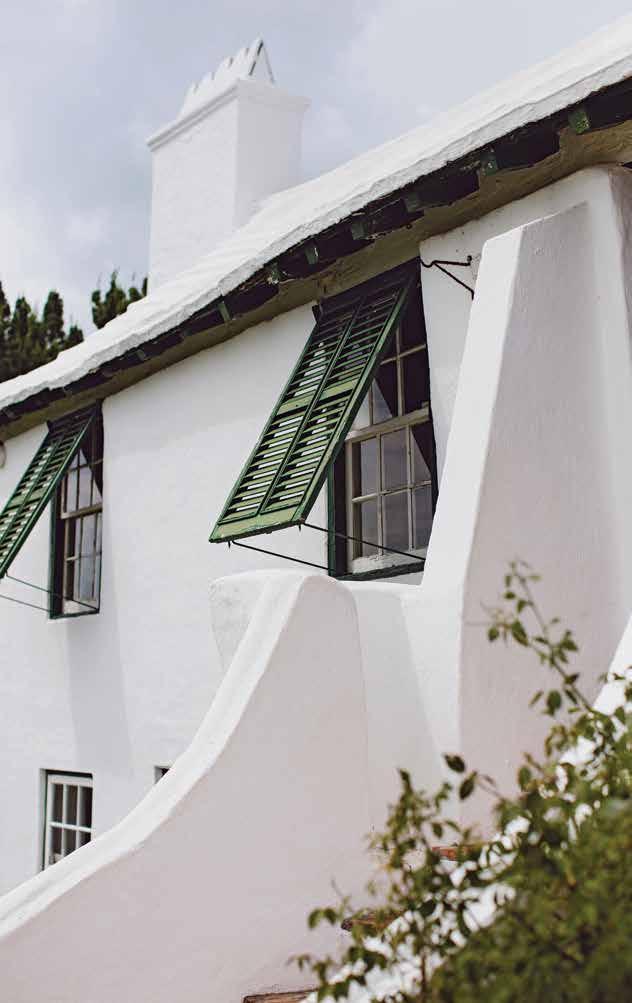
/ season 1 / fall & winter / / delight in being home & away /
/
1 /
/ /
/
season
fall & winter
delight in being home & away

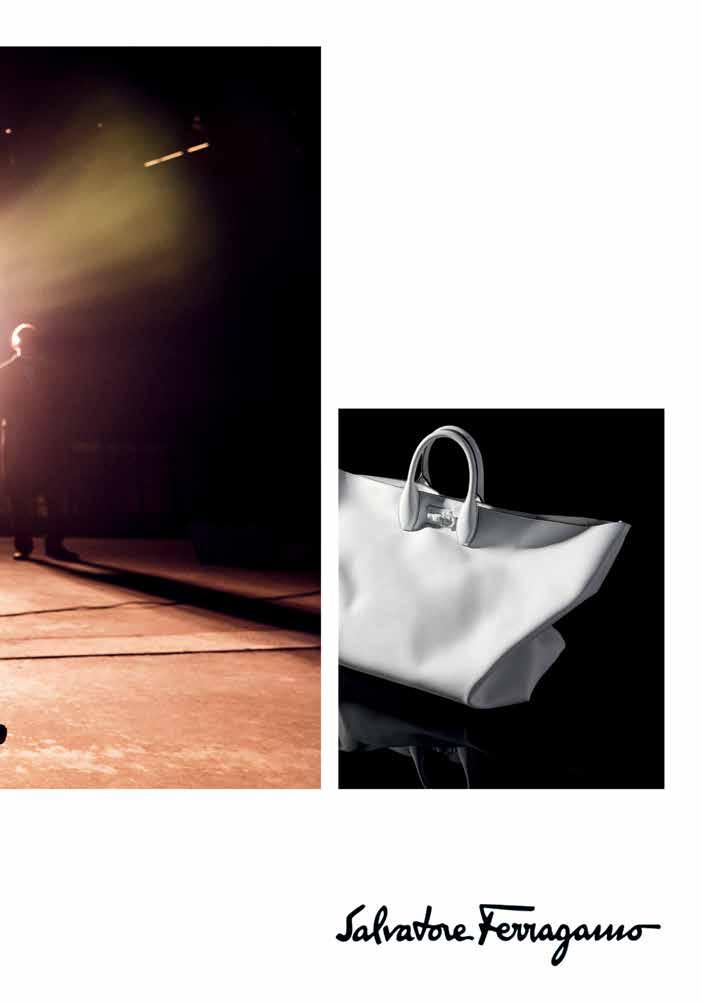




EDITOR'S LETTER
Herein is a starting point, a place to linger, a return home. Welcome to the inaugural issue of this new publication meant for Owners and real estate buyers around the globe who enjoy a lifestyle that is truly personal and distinct. Each season will showcase desirable destinations across Marriott International’s diverse portfolio of residential communities and celebrate facets of the luxury lifestyle owners experience every day. This season, for instance, consider the pure joy of a bluebird day in Deer Valley, or the rare talent of Chicago architect Jeanne Gang. Encounter unexpected delights in the Algarve region of Portugal and meet new faces in Bermuda’s East End. Every story herein shares the location of an exceptional Marriott International branded residence. We hope you linger over the pages and feel they are calling you home.
the iconic st regis tower designed by architect jeanne gang is home to the residences at the st regis chicago and is the tallest building in the world designed by a female architect photo by angie mcmonigal photography
08
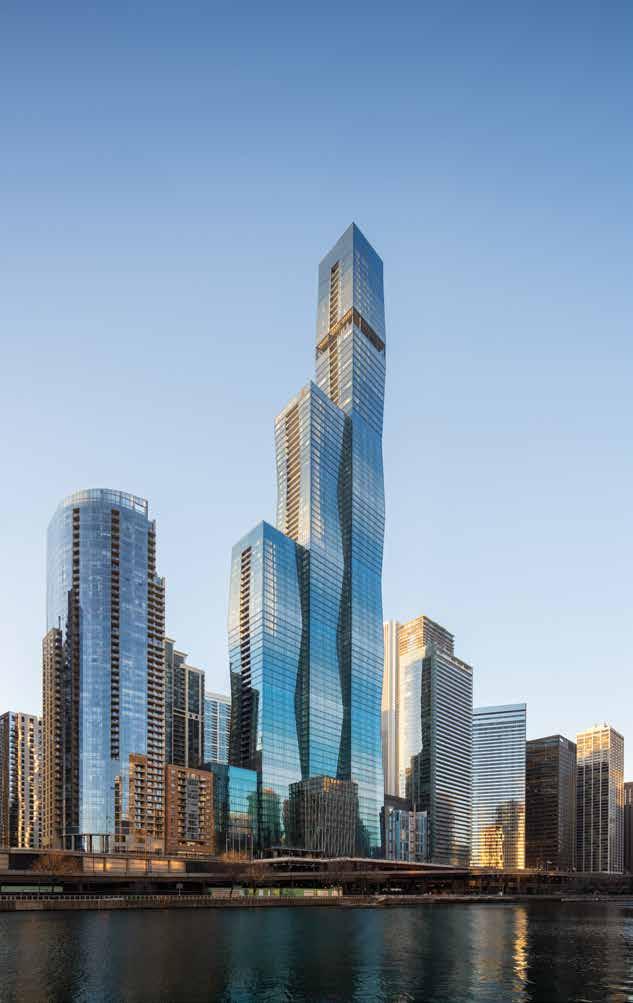
CEO & PUBLISHER
Jason Cutinella
VP GLOBAL CONTENT
Marc Graser
VP BRAND DEVELOPMENT
Ara Laylo
NATIONAL EDITOR
Anna Harmon
Operations
Joe V. Bock CORPORATE AFFAIRS
Merri Gruesser VP GLOBAL PARTNERSHIPS & DEVELOPMENT
Advertising
Marly Graubard
VP GLOBAL SALES marly@nmgnetwork.com
Mike Wiley VP SALES mike@nmgnetwork.com
Marriott International Residences
Amanda Altree VP, DEVELOPMENT & RESIDENTIAL BRAND MARKETING
Ayanna Wiggins DIRECTOR, GLOBAL RESIDENTIAL MARKETING
Published by: NMG Network
36 N. Hotel St., Ste. A Honolulu, HI 96817
©2021 by NMG Network. Contents of Herein are protected by copyright and may not be reproduced without the expressed written consent of the publisher. Herein assumes no liability for products or services advertised within. Herein is a semiannual lifestyle publication of Marriott International.
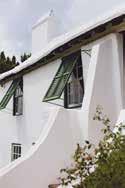
About the Cover
A quiet moment at the historic Carter House in St. David's, Bermuda, photographed by Meredith Andrews.
10
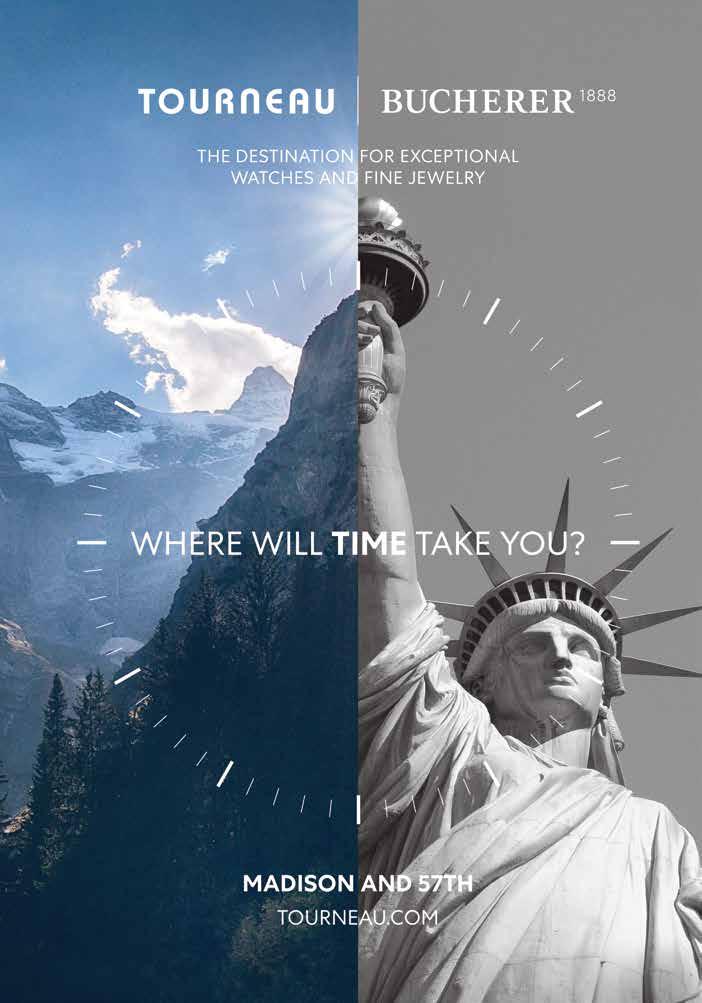
Chicago
BIRD’S EYE VIEW
Architect Jeanne Gang marries form and ecological function.
38
Boston SIP AND SAVOR
Learn the origin of the Bloody Mary and savor a custom recipe from The St. Regis New York.
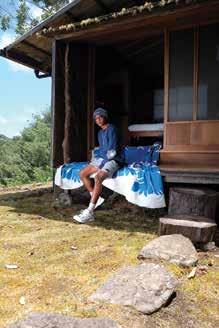
26
Hawai‘i
CRAFT AND CULTURE
Salvage Public draws endless inspiration from a Pacific archipelago.
30
Los Angeles
THE PARTY PLANNER
Julia Sherman shares her recipe for sophisticated yet engaging gatherings.
40 Global
BOUNTIFUL GREEN SPACES
Parks are indispensable to collective well-being. Here are four to visit.
42
New York City
SUBTLE SIMPLICITY
Té Company celebrates the overflowing variety of Taiwanese tea.
52
Bermuda TREASURED ISLAND
A photo essay celebrating the many facets of the East End.
68
Portugal AT SECOND GLANCE
A writer from Lisbon finds sanctuary and sustenance in Quarteira.
82
Hawai‘i
ARTIST IN RESIDENCE
Jean Charlot is ever present in his modernist home on O‘ahu.
90 Boston BREAKING BREAD
Finding community and a taste of home at immigrantowned restaurants.
102
Portugal
HOMETOWN HERO
Get to know singer Dino D’Santiago and his favorite spots in the Algarve.
112 Deer Valley ON BLUEBIRD DAYS
An ode to the wondrous conditions following a day of snow.
124 Miami BACK TO THE BASELINE
A writer’s unexpected injury throws the value of tennis into stark relief.
130 Global NOTEWORTHY DRIVES
Six roads around the world that are worth the journey.
134
Bermuda / New York LES NOUVEAUX
Discover the newest branded Marriott International residences.
138
Global LIST OF RESIDENCES
From Arizona to the U.K., these indexes reveal possible homes around the globe.
142
Costa Rica / Maryland / Mexico / Miami
WELL AND GOOD
How Marriott International Owners can find wellness wherever they are.
132
Hawai‘i
SERVICE SPOTLIGHT
A stay-at-home princess birthday for a 7-year-old resident at The Ritz-Carlton Residences in Waikīkī.
each story in herein shares a location with one or more of these residences .
12
16
fashion A brand rooted in Hawaiian culture | 33 image courtesy of salvage public
image by rodrigo cardoso
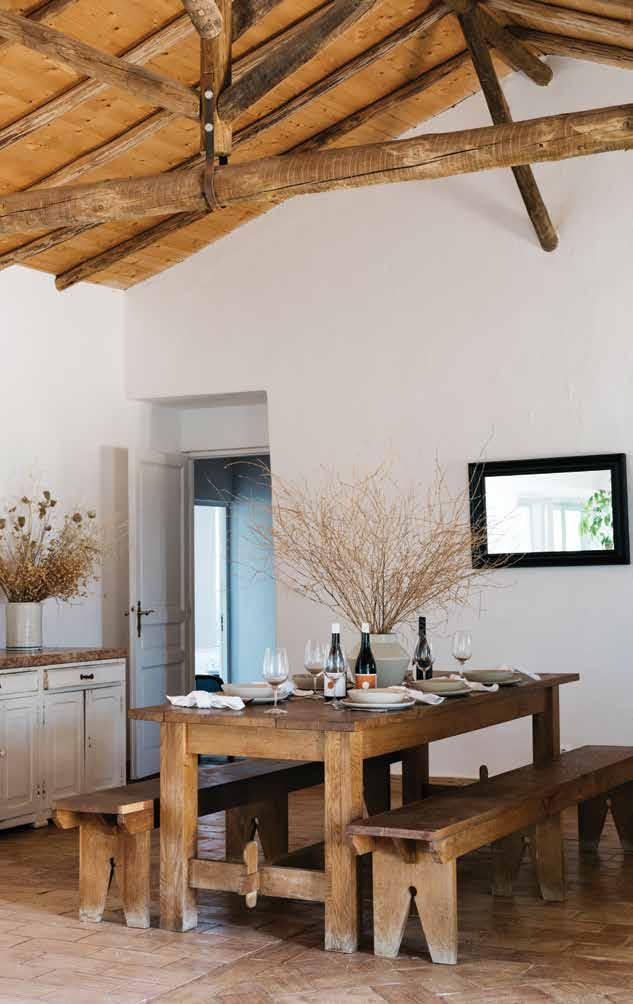
hello
A welcoming gesture.
A welcoming gesture
image courtesy of © sam fentress
bermuda / boston / cairo / chicago / hawai ‘ i / los angeles / miami / new york
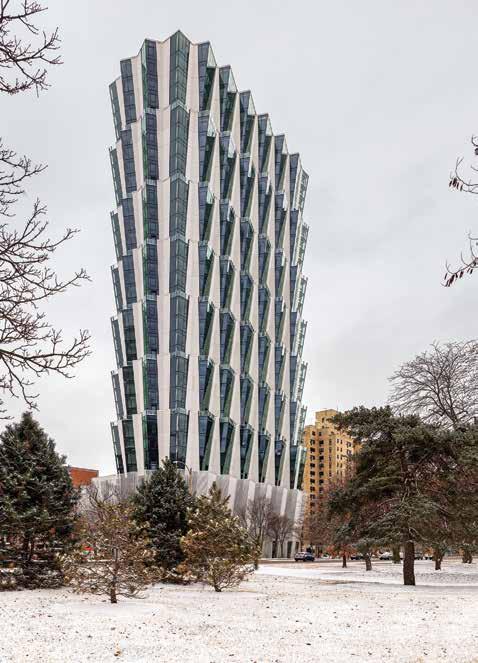
15
Bird’s Eye View
Historians of the future will list their names: Daniel Burnham. Louis Sullivan. Mies van der Rohe. Jeanne Gang. Over the past decade, the MacArthur fellow and founder of Chicago-based Studio Gang Architects has materialized as one of the most original voices on today’s architectural scene and solidified her place among the pantheon of visionary architects who called Chicago home.
the chicago architect jeanne gang marries form and ecological function text
timothy a . schuler images
by
courtesy of studio gang
a moment at studio gang ’ s aqua tower in chicago , image by steve hall © hall + merrick .
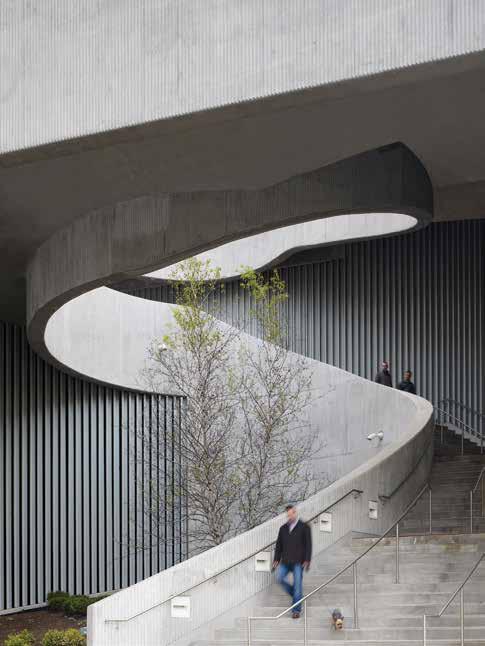
17 chicago / architecture
What began as a small but ambitious practice of one has grown into a collective of more than 200 designers in four offices: Chicago, New York, San Francisco, and Paris. Today, Gang is best known for buildings that, without any moving parts, feel kinetic. Chicago’s Aqua Tower sports rippling, white concrete balconies that give it the impression of a waterfall frozen in motion. Completed in 2010, it was the tallest building in the world designed by a female architect until Gang beat her own record in 2020 with Chicago’s St. Regis tower, home to The Residences at The St. Regis Chicago. The WMS Boathouse
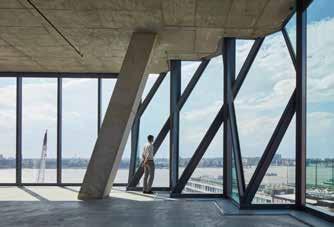
along the Chicago River features sawtooth roofs that evoke the graceful rise and fall of a rowing team’s oars. And One Hundred, a 36-story condominium tower in St. Louis, features repeating volumes of canted glass, which, like buds on a stem, seem perpetually about to bloom or unfurl.
This formal inventiveness is not about creating architectural drama for drama’s sake, or about winning accolades. For Gang,
the daughter of a civil engineer and a parttime librarian and quiltmaker, architecture is a public art. “Whenever you put something onto the Earth, you’re putting it in front of everyone,” Gang says.
Gang’s consideration of a building’s impacts extends well beyond the eventual occupant, beyond even a city’s human inhabitants. For years, she has been at the forefront of a generation of architects exploring how buildings and cities can address the climate crisis, from reducing carbon emissions to actively supporting urban wildlife. “I’m interested in how architecture can work together with the environment to enhance biodiversity,” Gang says.
An avid birder, Gang is particularly interested in bird-friendly design. For nearly 20 years, she has been vocal about the fact that buildings—and especially tall, transparent, glass towers—kill up to a billion birds each year. The danger is exceptionally acute in cities like Chicago, she says, which sits practically in the center of the Mississippi flyway, a major migratory corridor for many of North America’s native bird species. For the studio’s faceted Solar Carve tower in New York, which rises next to the city’s famed High Line and is also located in a major migratory flyway, Gang used glass with low reflectivity and a birdsafe frit pattern to reduce bird strikes.
As is often the case, when it comes to urban habitat, the solution to one problem brings problems of its own. For instance, the larger and more ecologically sound a green roof is, the more likely it is to attract birds and, if it’s surrounded by glass, increase bird
©
©
from left to right : looking out
from
solar carve in new york image
tom harris image of jeanne gang
ethan hill

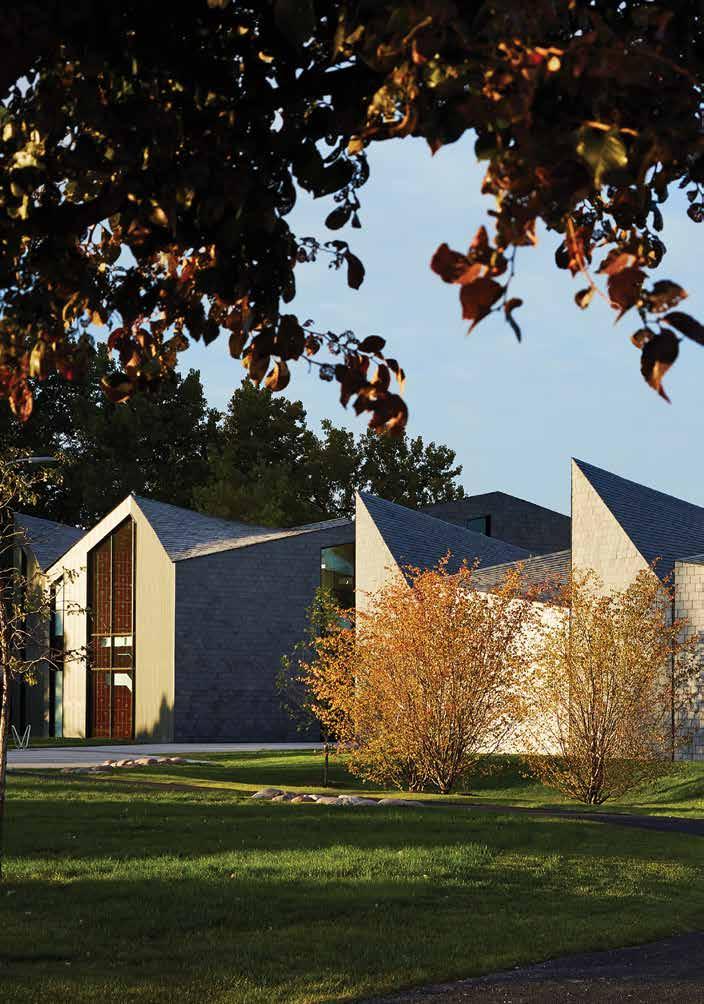
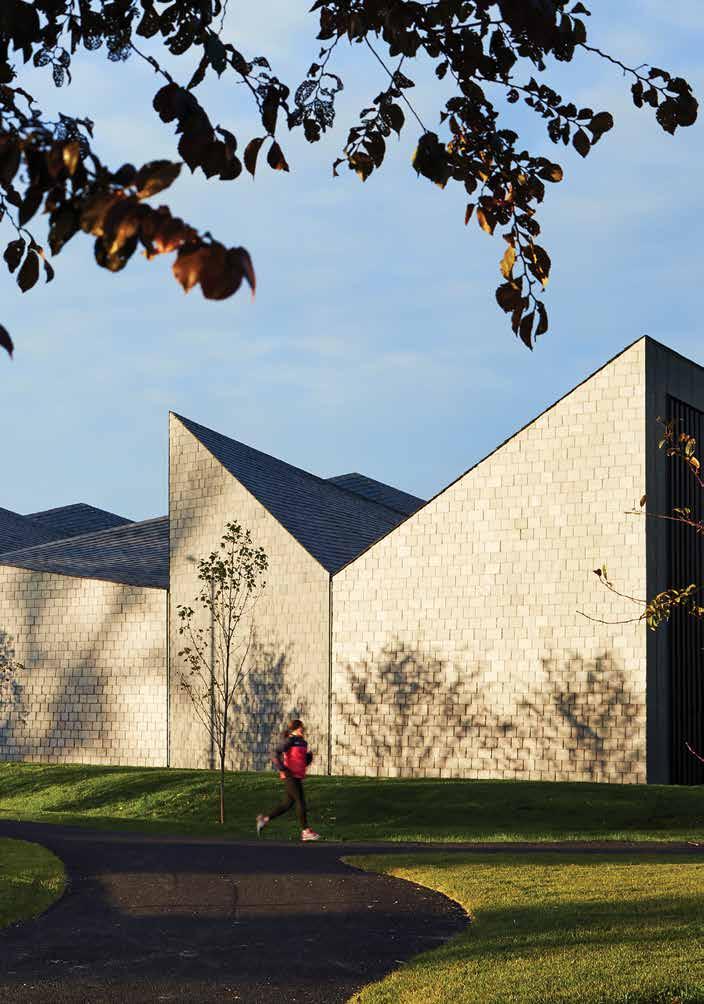
collisions, Gang says. As a solution, Gang’s team prioritizes using patterned glass near landscaped areas and avoids elements like a glass handrail in front of vegetation.
Undergirded by an ethic Gang calls “actionable idealism,” every Studio Gang project is informed by extensive research and design exploration, which involves no shortage of physical model-making and prototyping. (A significant amount of each office’s square footage is devoted to a bustling workshop.) Whether it’s a community firehouse or a university building, Studio Gang’s architecture responds to the cultural and climatic context of its particular site—sculpted to limit its exposure to direct summer sun or organized to dissolve the line between indoors and outdoors.
Increasingly, Gang is thinking about an Earthencompassing issue—specifically, how to decarbonize our cities. Currently, Studio Gang is overseeing construction on the University of Chicago’s Center in Paris, a 100,000-squarefoot academic hub and student residence with a central, switchbacking stair meant to serve as a vertical “campus quad.” Paris has “much stricter regulations” than the United States, she says, and they take into account embodied carbon, or the carbon emissions required to manufacture and transport building materials. From the very beginning, the project had a fixed carbon budget. “Every material is accounted for,” she says. “We just don’t do anything like that yet in the States.”
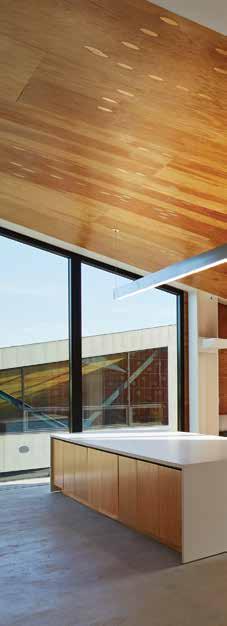
a quiet moment at wms boathouse at clark park previous spread , the boathouse exterior both images by steve hall © hall + merrick
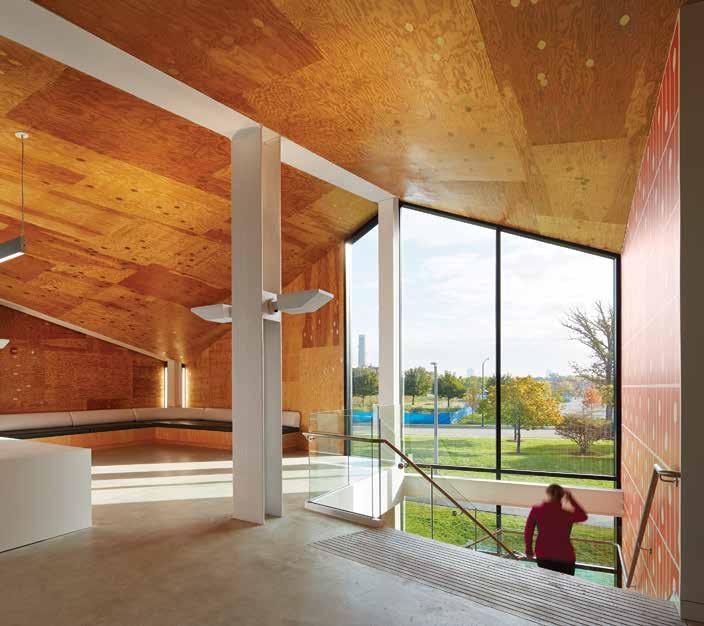
23
Closer to home, a proposal by Studio Gang for carbon-neutral workforce housing in Chicago recently won the C40 Reinventing Cities design competition, which aims to help global cities address the climate crisis. The project, known as Assemble Chicago and located downtown in the heart of Chicago’s Loop, would create more than 200 units of affordable housing atop a wellness clinic and event and meeting space for neighborhood nonprofits.
If built, Assemble Chicago would represent a radical new vision for how to live in the 21st century. Yet its architecture doesn’t dismiss the past. On the contrary, its brick masonry facade interprets elements of Chicago’s historic architecture, namely the bay window, which was invented to bring more natural light into people’s homes. It’s a fitting tribute to the city that launched Gang’s career, a city Gang has now shaped nearly as thoroughly as any architect who came before her.
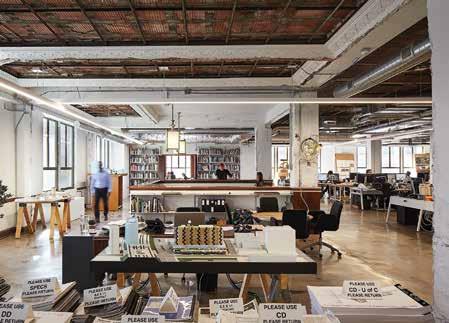
left is studio gang ’ s chicago office , image by © tom harris right is solar carve in new york , which overlooks the high line , image by © nic lehoux
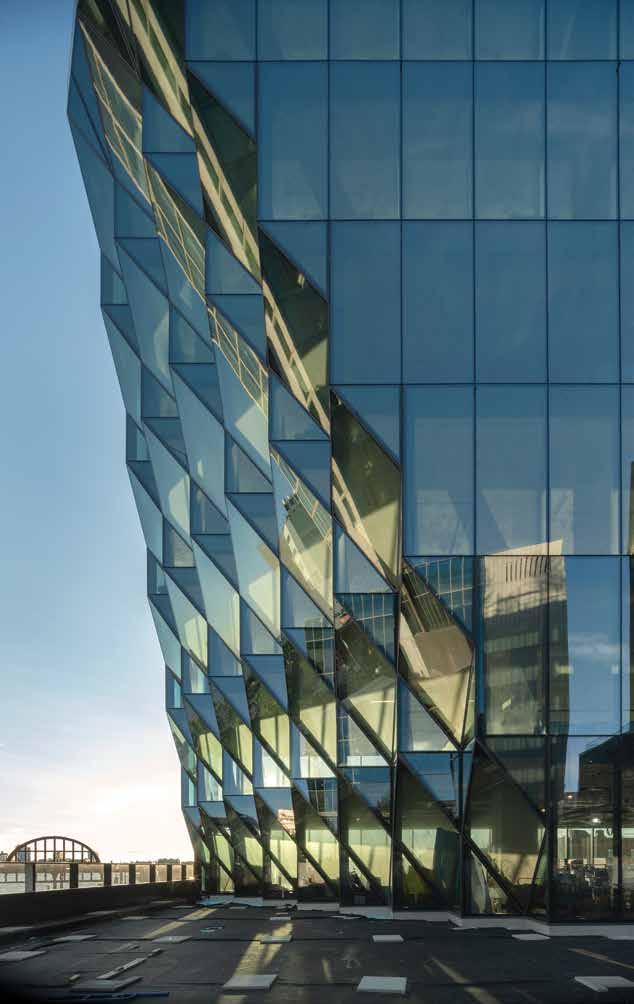
Craft and Culture
At first glance, the shirt seems straightforward: a leaf motif screenprinted on a cotton T-shirt. Yet its simplicity belies the design’s complex history and heritage. The leaf is laua‘e, a fragrant fern indigenous to Hawai‘i. And the design is in the kapa kuiki style, a quilting technique unique to Hawai‘i, passed on for generations in Joseph Serrao’s family.
“Some older people have come into the Salvage Public store and have asked me, ‘Is that a John Serrao design?’ And to me that to me is just, wow. That particular laua‘e is drawn in such a way that somebody can identify it to my grand-uncle,” Serrao says.
“It feels amazing for me to be wearing a piece of artwork that my grand-uncle did by hand. It feels grounding.”
fashion brand salvage public draws endless inspiration
from an island chain in the pacific ocean ,
text by eunica escalante images courtesy of salvage public
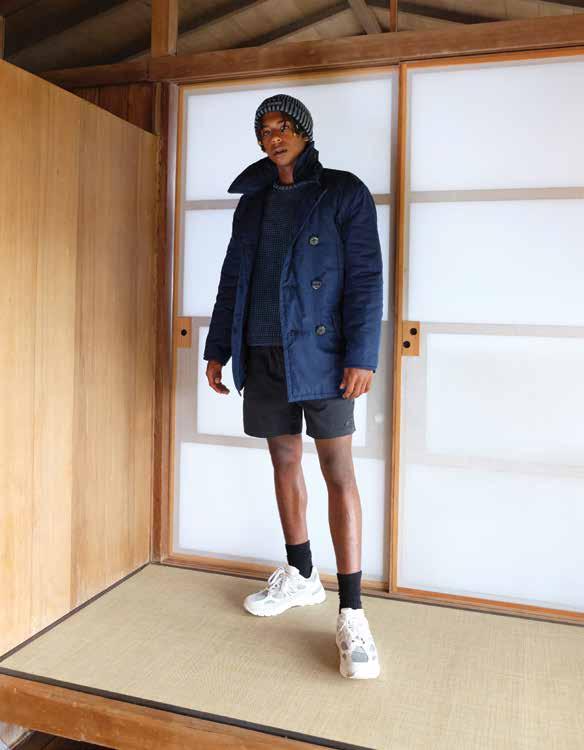
hawai ‘ i / fashion 27
Serrao is the co-creative director of Salvage Public. Started in 2013 by Serrao, his brother Noah, and their childhood friend Nāpali Souza, Salvage Public has become an iconic facet of the new Honolulu. In a landscape that has been dominated for decades by kitschy aloha wear, Salvage Public’s contemporary approach to Hawai‘i fashion stands out. Take, for example, the iconic silhouette of Diamond Head crater on O‘ahu, transformed by Salvage Public into an abstract yet recognizable logo. Or aloha shirts, reimagined into the Makani woven shirt, optimized for the tropics with its breathable fabric and mesh lining.
Their thoughtful approach to production also emphasizes craftsmanship. “When you look at it through a Native Hawaiian lens, craftsmanship has historically been very important to us,” Serrao says. From the simplest cotton shirt to their more luxury garments, like their Hawaiian prepwear suit sets or handmade eyewear, many designs are manufactured via a network of small Japan-based factories. As a result, each season’s launches are produced in small batches—making them limited releases and highly coveted by their global fanbase, which stretches from New York to Japan.
Despite their increased international popularity, Salvage Public maintains a creative focus rooted in Hawai‘i. As Native Hawaiians, the islands are woven into their identities and heritage. “We wouldn’t do anything else in terms of inspiration,” Serrao says. “That’s not who we are. The ultimate narratives for the authenticity of what we feel comfortable would always stem from here.”
a custom quilt from salvage public runs $10,000 .

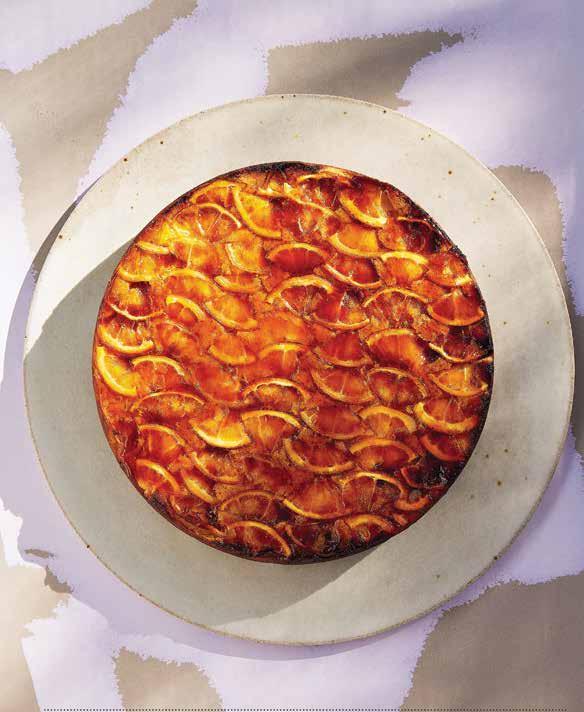
los angeles / culinary 30

The Party Planner
Artist, cook, and entertainer-abouttown Julia Sherman hosts parties that are often high concept. She has thrown flamboyant potlucks on museum rooftops and a book launch inside her favorite neighborhood grocery store. She’s hosted a rousing crawfish boil accompanied by a punk-rock marching band. For the originality and unconventional conceits of her get-togethers, Sherman never seems at risk of over-planning. But there’s also always a bit of sprezzatura to her affairs that lets the light and fun come in. In her new book, Arty Parties, an Entertaining Cookbook, Sherman revels in party particularities, with the help of artist friends.
images reprinted from arty parties : an entertaining cookbook
.
text by maggie lange
by julia sherman
photos by julia sherman . published by abrams
a gluten - free citrus cake highlights the artsy way
julia sherman cooks and hosts in her new book
julia sherman , known for her creativity in the kitchen and flair for entertaining , shares her recipe for gatherings
“The intention was to present entertaining in a way that felt like a different type of aspirational,” Sherman tells me. “It’s about entertaining as an opportunity to try something new, to experiment, to use your free time not to prove something to other people but to enrich your own experience.”
In fact, Sherman theorizes, everyone has a lot more fun if the party has a messier, looser spirit. In Arty Parties, the colorful, tangy recipes—for chamomile-poached white peaches and smashed winter squash with fried coriander—come alongside refreshing hosting tips and tablescape schemes, like a candelabra made of a gorgeous yet stale baguette. Taking stale bread and making it the centerpiece, it’s classic Sherman: There’s always room to transform mistakes into the most fun thing on the table.
Sherman, who has a background in fine art and took all the photographs for her new book, emerged as a host-to-know with her project Salad for President, an evolving conceit that connects food, art, and life.
She’s launched the juicy, sparkling, lowalcohol wine Jus Jus. She’s hosted events for MoMA PS1 in New York and Los Angeles’ Getty Museum. She also has near constant gatherings in her mid-century Pasadena home, where she lives with her husband and two small children. They have themed dinner parties and tie-dye parties every Labor Day to turned white clothes colorful in time for the changing seasons.
One of the reasons Sherman thinks their home is so popular is because they involve the guests in the process of party-throwing— which creates a sense of community.
Pinching dumplings or assembling a dessert with poached fruit, ice cream, and meringue involves all the guests, so people move around and talk to everyone as opposed to sitting in an assigned seat. This is the most important: “My guest list is a whole group of infinite combinations of potential friendship,” she says. Moving, shaking, assembling a meal: “It’s a dynamic and lively way to entertain.”
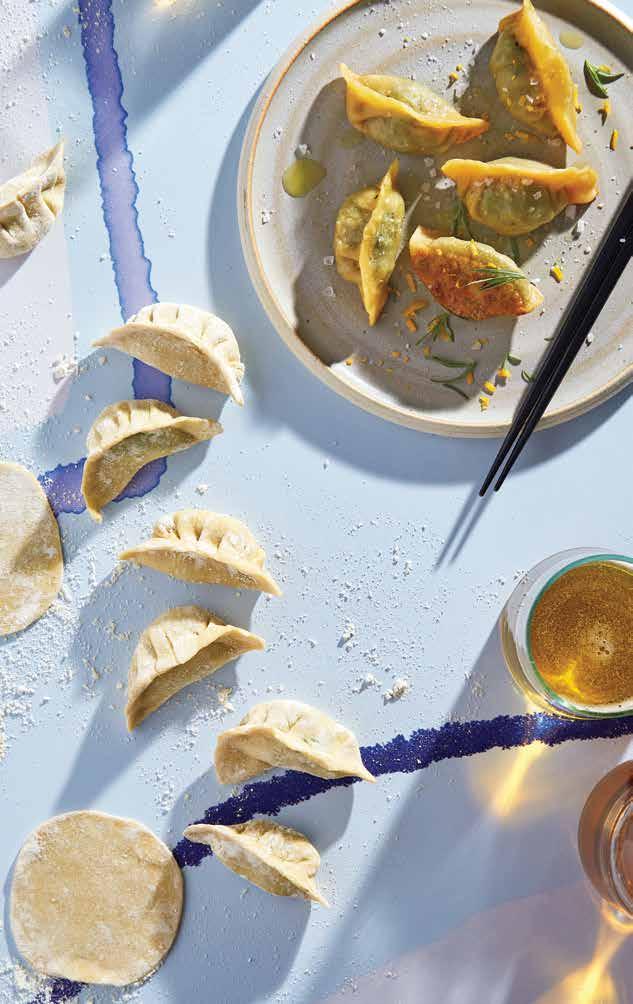
Julia Sherman’s Hosting tips
Plating as a Playful Composition…
“Some things look good in large quantities and some things look good in small quantities. I approach [plating] like a sculpture: You give it room to breathe. I have an avocado-lemongrass panna cotta made with Greek yogurt, unusual herbs, and toasted nuts. I set the panna cotta in my grandmother’s old crystal glasses. Having fun with the presentation feels luxe!”
Along with Salt and Pepper…
“On the table, I usually leave out a nice finishing olive oil and lemon slices, so if people feel like they want more acidity and they want more salt it’s there for them. My friends joke—no matter what I am cooking, I text someone before the party to bring a lemon.”
sherman emphasizes the playful yet tasteful opportunities of hosting photo courtesy of julia sherman
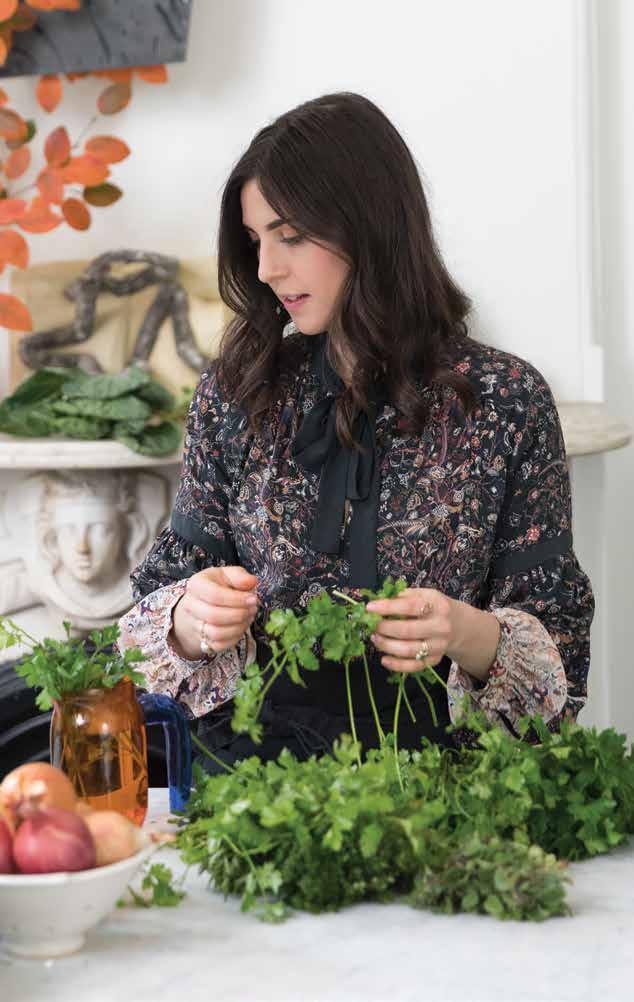
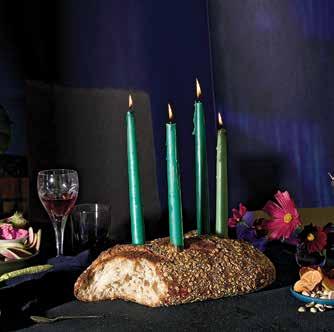
An Easy, Beautiful Snack…
“Every special wine store has a huge selection of conservas, imported tin fish. They are luxe, you get a special tin of sardines or marinated mussels— and if I’m really being lazy, I like to serve them out of the tin with a loaf of bread, sliced preserved lemon, and drinks. Every tin has a different taste, the packaging is beautiful. I love snacking and finger food. There’s no shame in skipping the dinner part of the party.”
A Note for the Atmosphere …
“I’m not shy about delegating. People feel like if they host they need to see everything through, but people like to be involved! The thing that I offload to my husband is music. He likes to tailor the music to the vibe or the theme. If we’re having Japanese, he’ll play music from that country to round it out. That [matchy-matchy choice] could be cheesy, but if you do a little research ... it can bring the whole thing together.”
a candelabra made using stale bread transforms a mistake into a playful centerpiece .
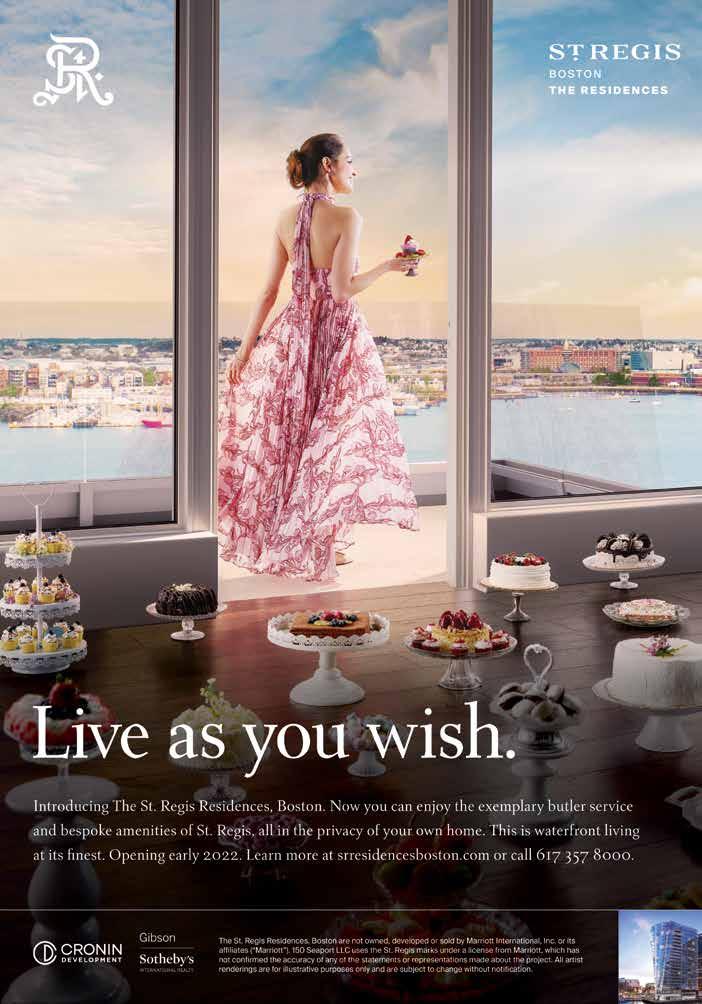
Sip and Savor
The iconic Bloody Mary cocktail, the signature drink of The St. Regis, was invented in 1934 right after the repeal of Prohibition, much to the delight of thirsty New Yorkers on Fifth Avenue. Acclaimed barman Fernand Petiot perfected the spicy vodka and tomato-juice recipe in the hotel’s King Cole Bar. Originally christened the Bloody Mary, it was renamed the decidedly less risqué “Red Snapper” so as not to offend the elegant hotel guests. While the name may not have stood the test of time, the savory comfort cocktail surely has.
Now, every hotel and resort in the St. Regis portfolio has crafted its own unique, locally inspired interpretation of the signature cocktail, and the residential portfolio is getting in on the action as well. The newest recipe addition to the St. Regis’ Bloody Mary legacy is the “Boston Massacre,” served only at St. Regis Residences in Boston, opening in 2022.
The Boston Massacre, a deadly riot that occurred on King Street in Boston in 1770, is an important part of Boston and Revolutionary War history, energizing anti-British sentiment and paving the way for the American Revolution. The “Boston Massacre” cocktail pays tribute to this significant event while touching, tongue in cheek, on the signature St. Regis cocktail, The Bloody Mary.
Residents at The St. Regis Residences, Boston, the first St. Regis in the historic city, will be able to enjoy their cocktails from an entire floor of luxurious amenity spaces overlooking the beautiful seaport. They will even be able to charter a yacht from the waterfront property to celebrate at sea.
learn the origin story of the bloody mary at the st regis new york and sample its newest rendition at the st regis residences , boston
boston / culinary
The St. Regis New York
Red Snapper, circa 1934
ingredients :
1 oz / 30 ml premium vodka
11 oz / 325 ml bloody mary mix
1 lemon wedge , for garnish
the signature bloody mary mix : juice of 3 lemons
2 1/2 #10 cans / 2 1/2 large tomato juice
5 oz / 150 ml worcestershire sauce
10 dashes / 3 ml tabasco sauce
2 tbsp / 30 g freshly ground black pepper
2 tbsp / 30 g ground cayenne pepper
1 tbsp / 15 g ground celery salt
2 tbsp / 30 g whole black peppercorns
directions :
Fill 12 oz (1/2 L) bloody mary glass with ice. Add vodka. Fill the glass with bloody mary mix and garnish with lemon. Pour ingredients into a container and shake well. Use immediately or seal and refrigerate. Strain peppercorns from the mix before adding alcohol. Makes 3 gallons (11 L).

39
marriott international
Treasured Green Spaces
Around the world, people have awakened to the incomparable benefits of spending time in green spaces. Offering respite and opportunities for gathering and exploration, these four famous parks and gardens remain as treasured today as when they first opened.
In colonial America, the notion of land held for the public good started with Boston Common, established in 1636 and used early on as pasture for grazing. Four centuries later, the storied park, which boasts 200-year-old trees, remains the heart of Boston. Extending from Boston Common is the equally significant, 1,100-acre chain of parks and boulevards known as the Emerald Necklace. Conceived by Frederick Law Olmsted, the visionary behind Central Park, and completed in 1895, this network of treelined streets and urban refugia has since served as a model for park systems around the world.
 text by timothy a . schuler
artwork by naomi clark
text by timothy a . schuler
artwork by naomi clark
an iconic legacy boston common and emerald necklace , boston
uniquely capable of providing beauty , recreation , and access to nature in moments of crisis , parks large and small have proven themselves indispensable to our collective wellbeing
Since its unveiling in 1929, Al Andalus Park has been a place where art, culture, and nature quietly intermingle. Part of a collection of century-old parks and gardens that emerged from efforts by Cairo’s rulers to westernize the city, the park features mesmerizing stepped gardens and ornate Arabesque, Andalusian, and Pharaonic architecture, all within view of the Nile River. The lush oasis was designed by architect Zulfugar Ali Pasha, who also gave Cairo its first Japanese garden. Today, the park is dedicated to Ahmed Shawqi, known as the father of modern Arab literature, whose statue overlooks the Andalusian garden.
the civic stage soundscape park , miami beach
In just 10 years, Miami Beach’s 2.5-acre SoundScape Park has become an integral part of the city’s arts and culture scene. Instantly recognizable for its swirling “clouds” of pink-flowering bougainvillea, the stylish and contemporary park, designed by Claire Agre and the Dutch design firm West 8, was conceived as a companion to the city’s New World Symphony Concert Hall, an outdoor living room that could accommodate a wide range of events. At night the shady, palm-strewn lawn transforms into a hightech, open-air performing arts space, with movies, musical performances, and video installations projected onto the concert hall’s facade.
Sometimes green spaces are best experienced in motion. Bermuda’s Railway Trail National Park is a linear park that stretches nearly the entire length of the archipelago, following the route of the island’s short-lived train line known affectionately as the “rattle and shake.” Initiated as part of a worldwide rails-totrails movement, the Bermuda rail line was converted into a scenic biking and walking path in 1964. Along its path are secluded beaches, secret gardens, and dizzying array of island ecosystems, not to mention ample opportunities to appreciate the colorful architecture or take a dip in the ocean.
connected guide boston , cairo , miami , bermuda 41
an oasis on the nile
al andalus park , cairo
off the beaten path railway trail , bermuda
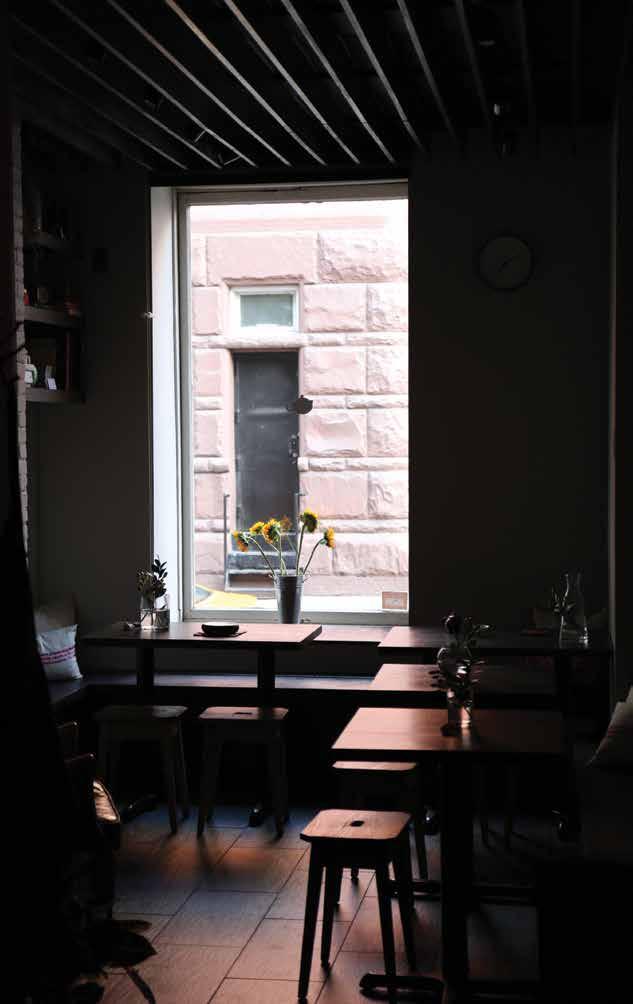
from just one plant and one island unfurl endless dimensions in taste and tradition at a tiny tea room in new york .
The Richness of Simplicity
new york
text by martha cheng images courtesy of té company
43
When Elena Liao began focusing on tea, she learned of the tiny tea cricket whose bite gives the oolong tea Oriental Beauty its characteristic honeyed rose flavor—the more bitten the leaves, the more hormones they secrete for preservation, resulting in a subtle sweetness in the final infusion. She learned of milk oolong, also known as jin xuan, which tastes of custard, though no dairy is introduced in its processing. But what most surprised Liao: All tea is made from the same plant. Oolong, green, white, black, matcha, Darjeeling—all produced from Camellia sinensis. What sets apart each type of tea is how it is processed and the cultivar.
As Liao delved deeper into tea, an immense world opened, as diverse and complex as wine. She sought an anchor in the island where she was born: Taiwan. Growing up in Taipei, Liao drank tea like water. She moved to the United States in middle school, and in her 20s and 30s, worked in fashion merchandising in New York. She remembers friends being confused about what she was drinking. For those used to steeping sachets filled with tea resembling black dust, or perhaps—a step up—broken shards of leaves, the whole leaves of fine tea that unfurled in Liao’s cup, voluminous like a kelp forest in a pot, were utterly foreign.
Liao realized that the centuries-old craft and tradition of tea were virtually unknown in the U.S. She focused on teas grown in Taiwan, which are lesser known in the tea industry—the island produces only a small fraction of the tea in the world, and much of it, grown on small family farms, stays there. She began wholesaling teas to highend restaurants but soon realized that teas were a low priority for them.
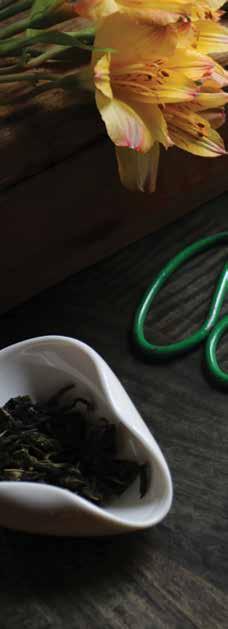
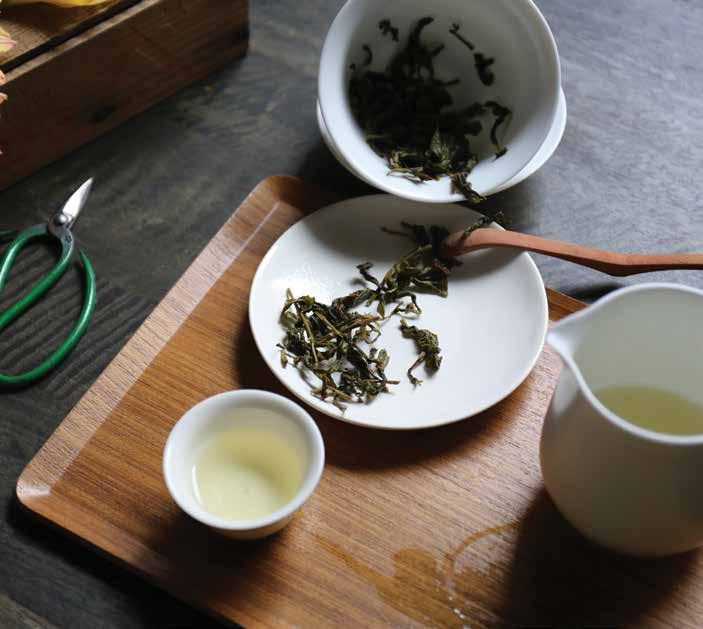
45
So she opened Té Company (Té is “tea” in Taiwanese) in the West Village in 2015, a hushed yet cozy sanctuary where she could control the entire experience, from brewing to serving. The teas are accompanied by “snacks,” refined versions of Taiwanese comfort food, including pineapple linzer cookies, a take on Taiwan’s iconic pineapple cakes, made by her husband, Frederico Ribeiro, a former sous chef at Per Se.
Every spring (at least before the pandemic), during the tea harvest season, Liao has travelled to Taiwan to discover and check in with tea producers. The way that Beaujolais, France is famous for its eponymous wine, regions in Taiwan evoke certain teas. Nantou County in the high mountains of central Taiwan, for instance, is historically famous for its Frozen Summit tea. From a family that has been tea farming for generations in Nantou, Liao sources a selection of Frozen Summit tea, including a vintage version, wherein the tea is aged. “Like people, they mature,” she says. Every year, it’s roasted to rid the moisture, resulting in a “closely watched aged tea” that tastes of toasted walnuts, perfect for fall.
Liao also seeks out one-off teas on her visits to Taiwan. While Maokong in the mountains near Taipei is known for a heavily roasted tieguanyin tea, “that doesn’t mean that on one of the farms, mom doesn’t have a side project where she’s making a white tea that tastes like vanilla,” she says.
“Taiwan tea is always very beautiful by default,” Liao reflects. “And usually, the teas I pick are elegant, flavorful, very aromatic. I like them to feel a little soulful and I don’t like too many distractions. I’m a little bit of a purist in that way. I don’t like to add things.”
How To Brew Tea With No Tools
courtesy of té company
Also known as “grandpa-style tea brewing,” this method makes it possible to enjoy whole leaf tea wherever you are, whether you’ve just arrived home or are on the road.
what you ’ ll need :
Kettle
Cup or large mug
Tea
brew time : One to two minutes (depending on the tea and personal taste). You can re-steep the tea leaves by adding more hot water at least 2-3 more times, so don’t discard the leaves.
step 1 : Use your hand to measure the tea. Approximation works because if it’s too strong you can add more water and if it’s too light, you can increase steeping time. Add loose leaf tea directly into the cup.
step 2 : Add hot water over the leaves. Refer to individual tea descriptions for suggested brewing temperature (195, 200, or 212 degrees Fahrenheit). You will see the tea leaves expanding and starting to sink to the bottom of the cup.
step 3 : Drink directly from the cup. If necessary, use your teeth as a strainer.
step 4 : Like any other loose-leaf tea, brewing more than once is recommended. Add hot water when you have about one-third of the infusion left—that way you get a second cup of tea that’s perfect in strength and temperature. The more steepings made, the more the leaves sink to the bottom of the cup, making it easier to drink.

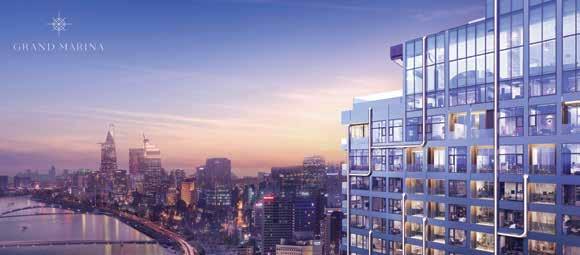
Introducing the largest Marriott branded residences in the world, located in the central business district of Ho Chi Minh City.
Arising star on the world stage, Vietnam is the fastest-growing economy in Southeast Asia and is forecasted to be the fifth-fastest in the world. The country is on track for a golden age of prosperity that shows extraordinary potential in the years to come.
Grand Marina, Saigon, developed by Vietnamese award-winning luxury property developer Masterise Homes, is Marriott International’s first foray into Vietnam’s highly vibrant branded residential sector. Located between the Saigon River and the Botanical and Zoological Gardens, this ultra-luxury development in District 1 links residents both to the soul and serenity of the riverside, and to the cultural and commercial centres of Vietnam’s cosmopolitan heart.
Metro entrances at the doorstep puts the entire city within easy reach. Within moments, owners find themselves at city’s key landmarks or immersed in Saigon’s haute shopping and dining scenes.
The Grand Marina, Saigon masterplan is a world unto itself, featuring eight residential towers rising from the shorefront, a landmark 850-meter waterfront promenade and a series of manicured public gardens and themed parks. Buyers can choose from two collections of superlative residences to match their desired way of living - The Prime Collection (Marriott Residences) and The Legacy Collection (JW Marriott Residences).
Following a successful debut in Hong Kong, this luxury development is set to captivate buyers in other international markets - those who pursue the highest standards of modern living.
the heights of modern living
ho chi minh city | advertorial grandmarina@masterisehomes.com masterisehomes.com/grand-marina-saigon facebook.com/OfficialGrandMarinaSaigon
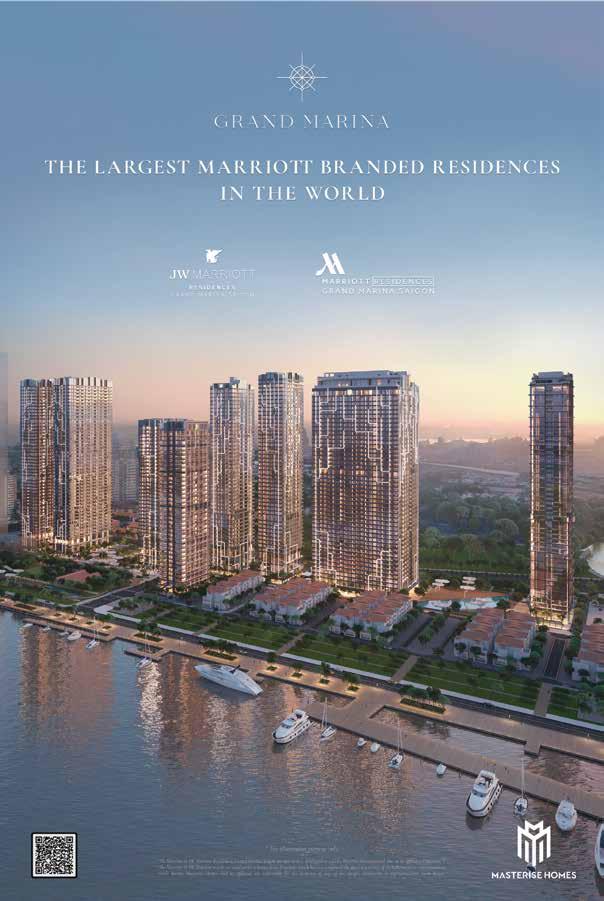
A welcoming gesture.
A haven worth savoring
bermuda / boston / chicago / hawai ' i / portugal image by meredith andrews
home
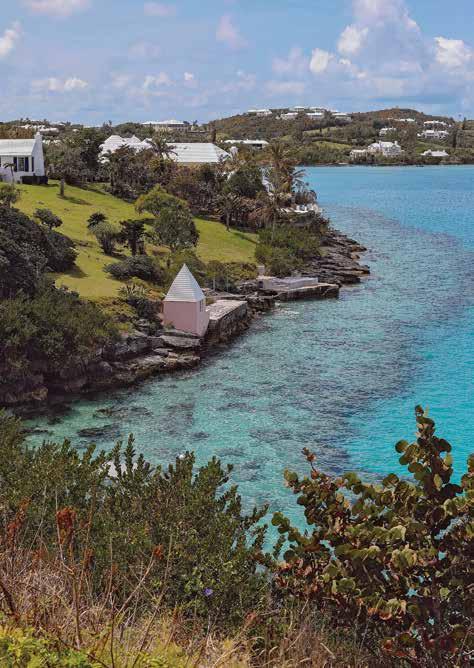
51
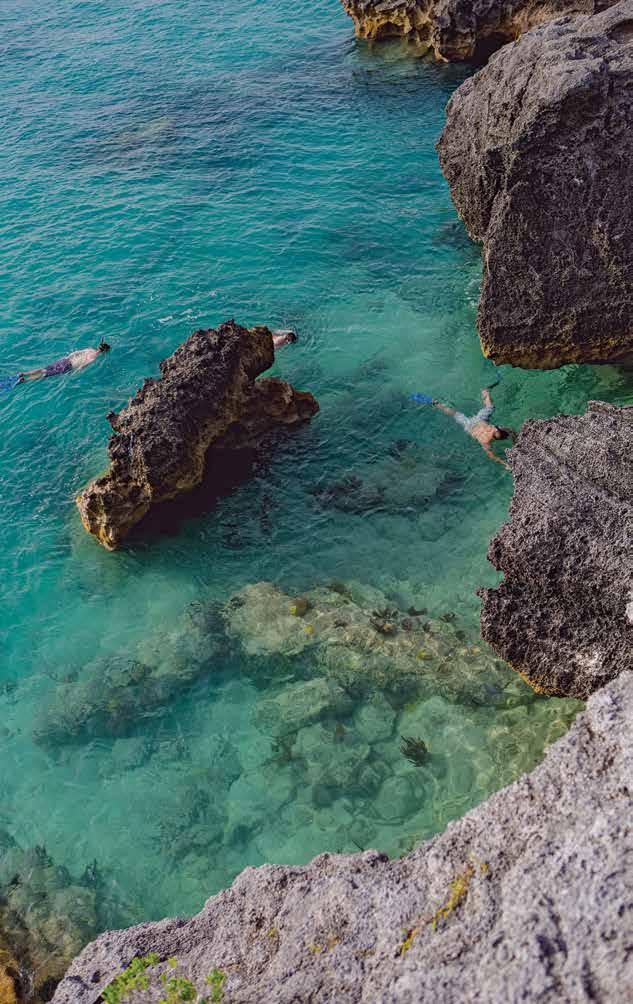
encounter the east end of bermuda with this photo essay celebrating its residents , historical highlights , and natural beauty .
Treasured Island
a photo - worthy destination bermuda
images by meredith andrews
53
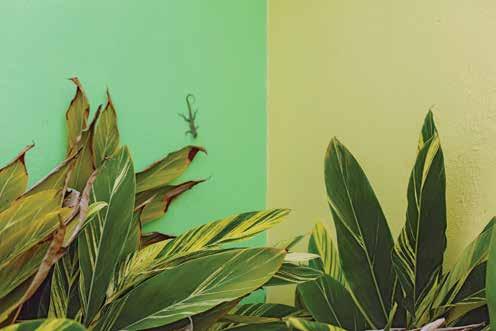
Bermuda’s East End was the site of the country’s first shipwreck, its first settlement, and its first capital. The region has stunning beaches, gorgeous vistas, and adorable cobblestones streets with candy-colored houses. According to photographer Meredith Andrews, who has always lived in the central parishes of the island, it is old world and new Bermuda all rolled into one.
There is a lot to do in the East End, she says, yet it’s all close together. A large part of the town of St. George’s is a UNESCO World Heritage site, and there are historical
buildings seemingly around every corner. Where St. George’s is quaint, St. David’s is quiet; there, the pace of life seems to slow down, according to Andrews.
Like all places, it’s the people who help define the East End. From volunteers at Carter House, one of Bermuda’s oldest homes, to the owner of the design store MERCH, to a tour guide at Fort Saint Catherine, the East End is full of passionate residents and business owners. With this in mind, Andrews, who regularly visits the East End, spent a day capturing street portraits and sumptuous views for Herein.
volunteer lynn mello is dressed in period costume at carter house , one of bermuda ' s oldest homes
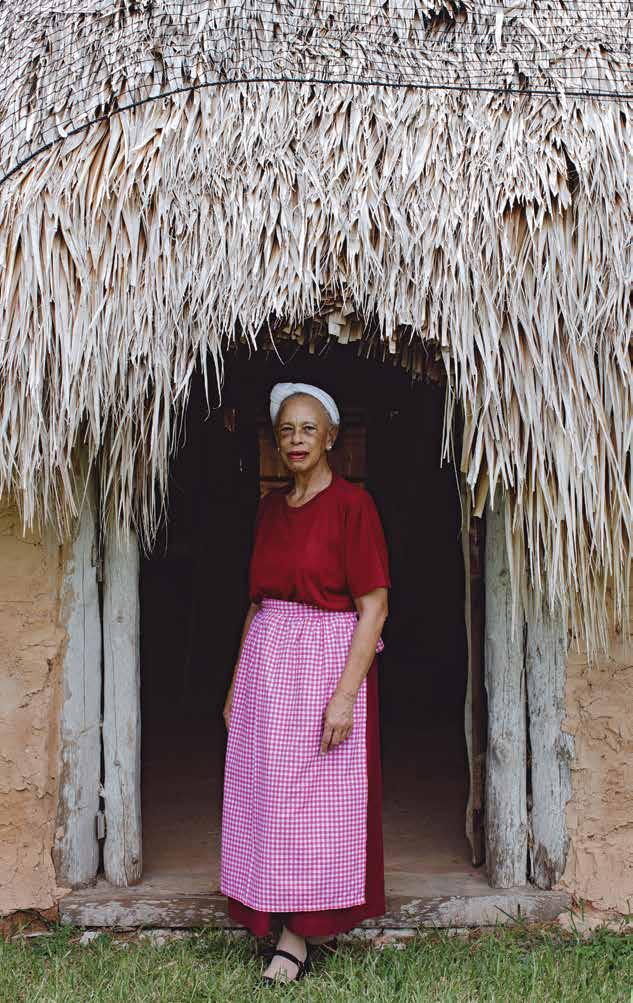
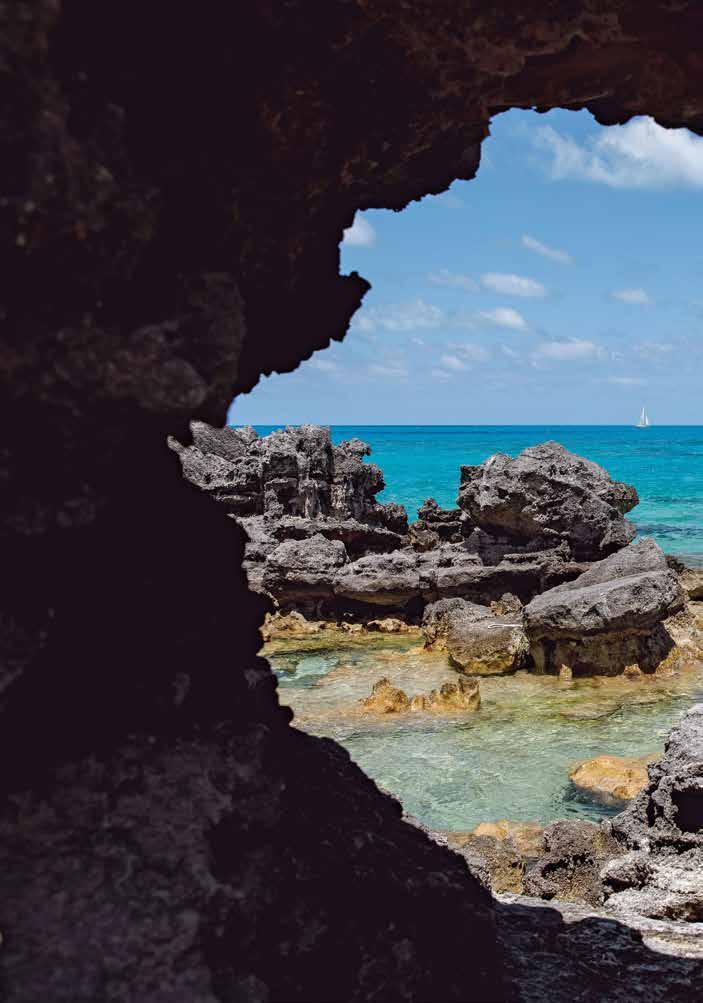
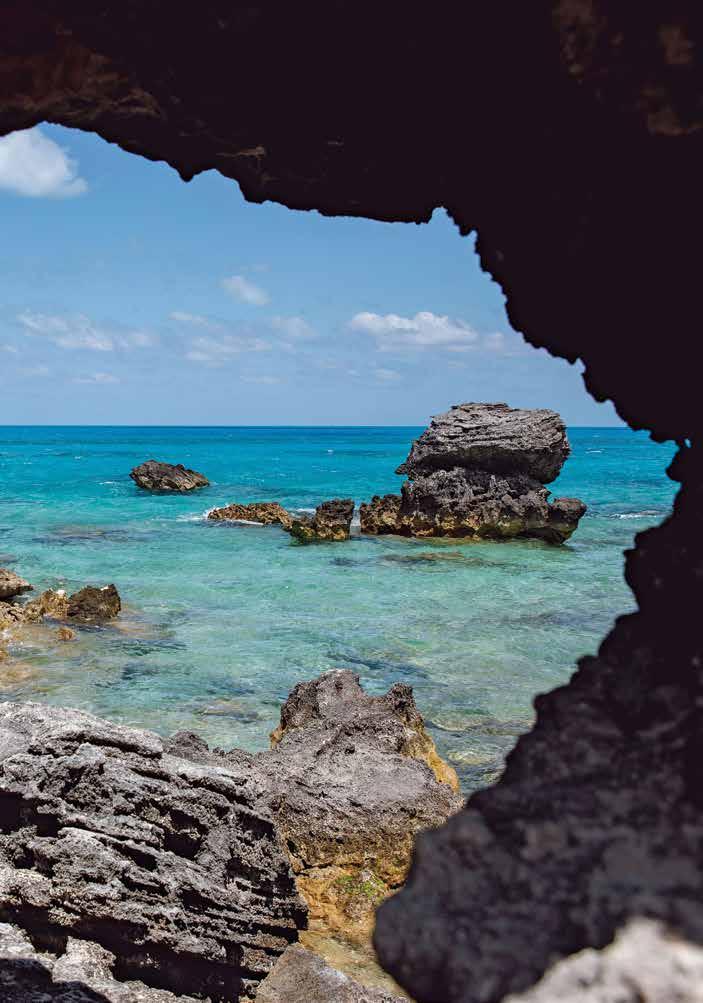
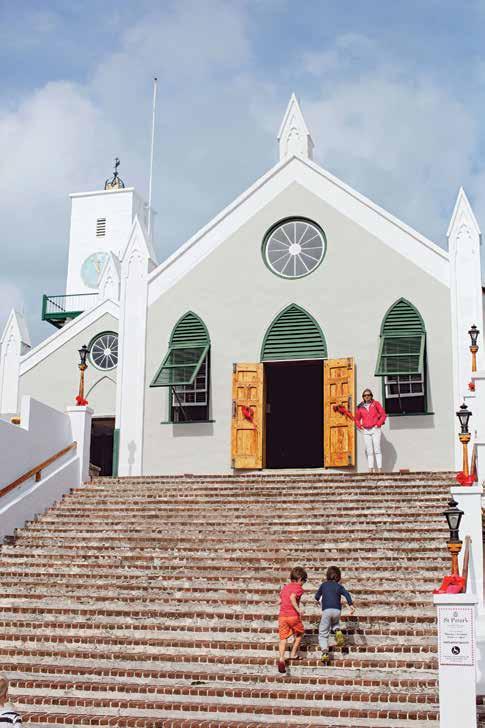
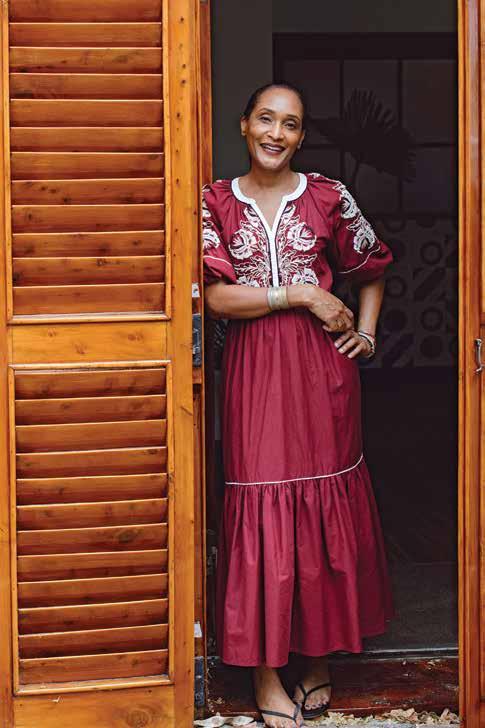 st peter ' s anglican church and nike bada , owner of merch design store , in st georges
st peter ' s anglican church and nike bada , owner of merch design store , in st georges
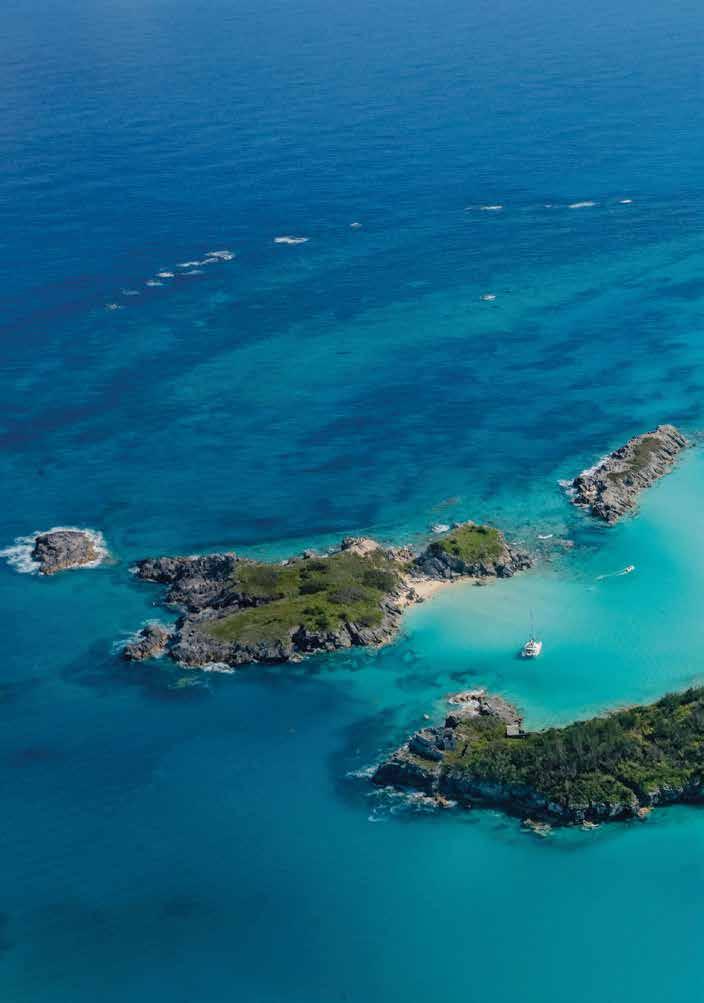
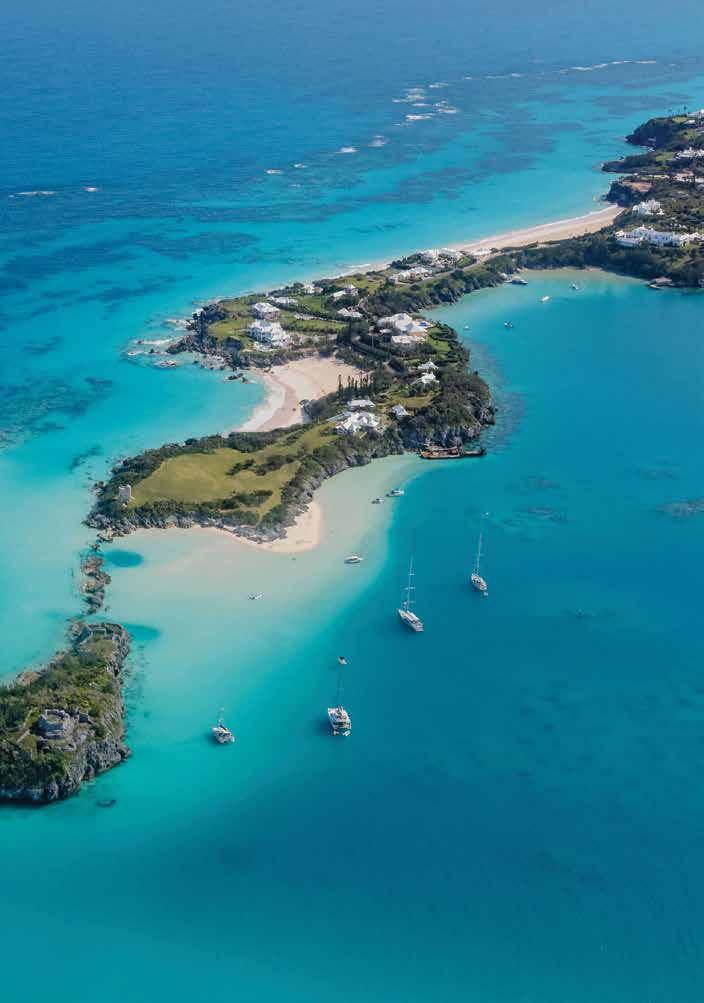
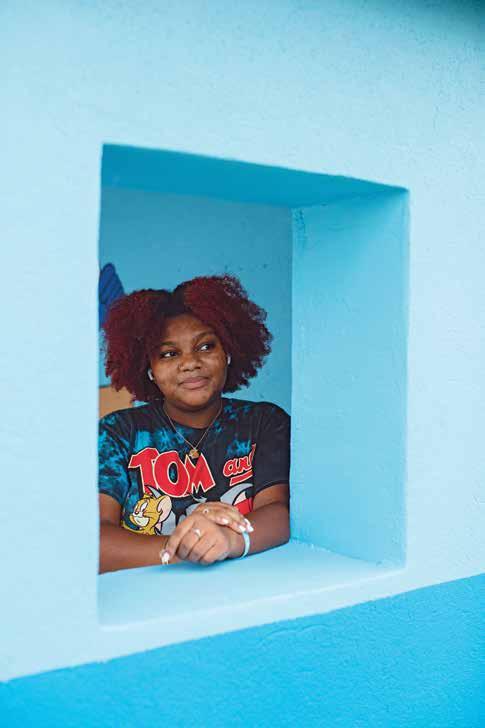 eastender christina gibbons waits for the bus in st george ' s
eastender christina gibbons waits for the bus in st george ' s
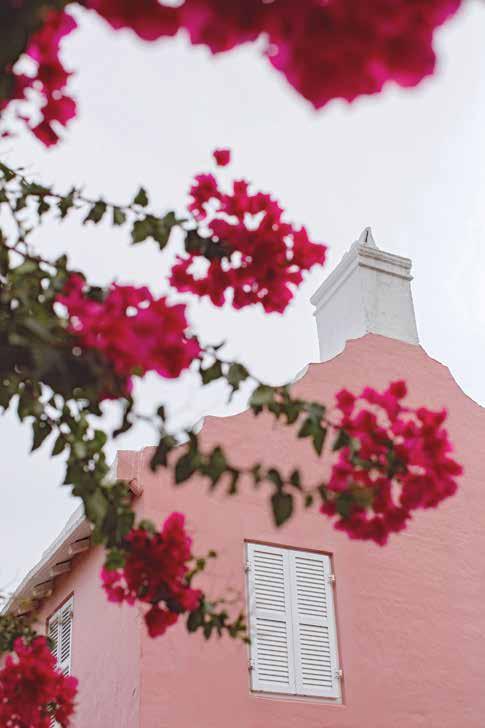
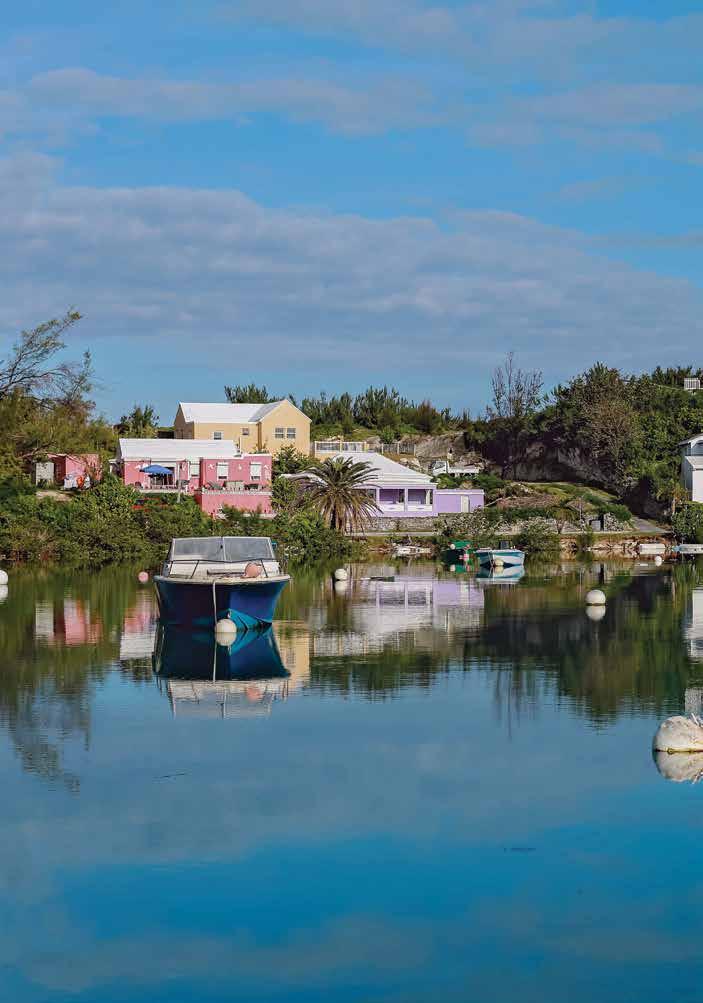
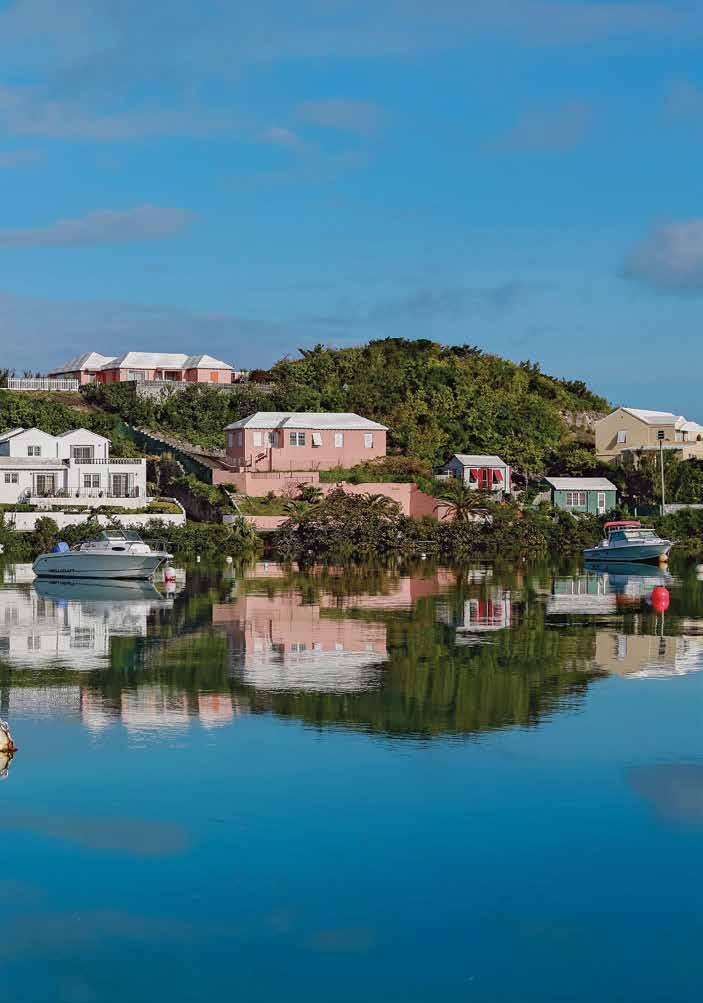
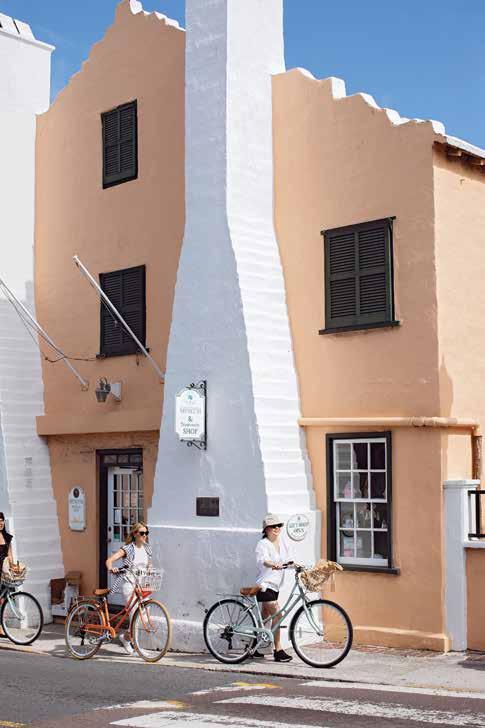
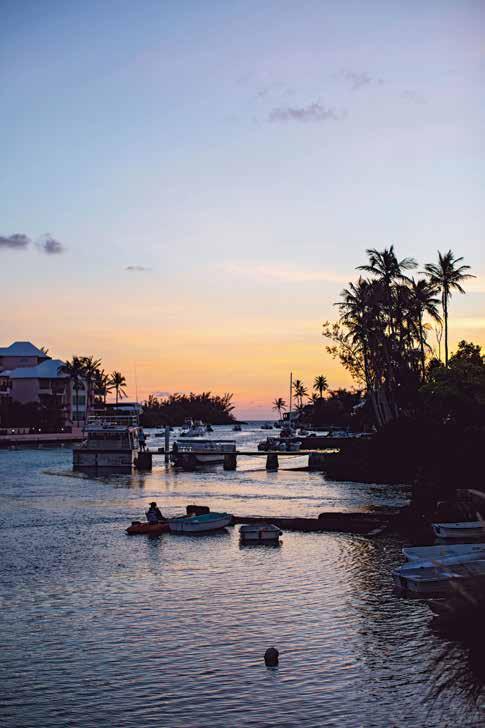 st peter ' s anglican church and nike bada , owner of merch design store , in st georges
st peter ' s anglican church and nike bada , owner of merch design store , in st georges
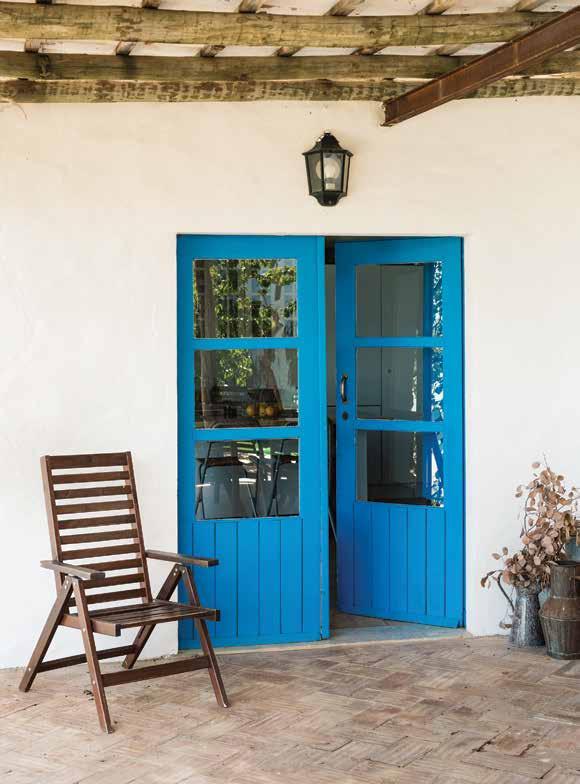
portugal / destination 68
At Second Glance

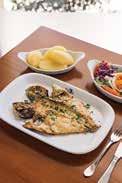
from left to right ,
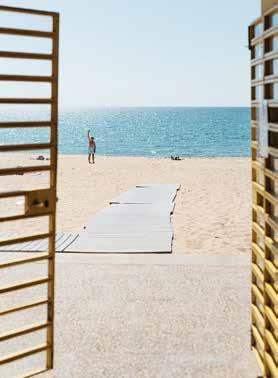
Truth be told, Quarteira rarely makes a list of best places in the Algarve region of Portugal. Until recently, the city wasn’t even on my own list, even though I’ve been spending a good bit of time there for the past three years.
text by ann abel images by rodrigo cardoso
a writer from lisbon finds sanctuary , sustenance , and a growing affinity for quarteira in the algarve
clockwise : a scene at winery morgado do quintão , diners at tico tico , the main beach in front of quarteira town , a simple meal from a caravela
It probably didn’t help that colleagues in Lisbon, my adopted hometown, continually asked why I—a longtime luxury travel writer whose taste runs more toward small, soulful hotels—keep going there. But I have the best answer to this question: love. A few years ago, I met someone who lives in Quarteira, and my relationship with him meant a relationship with the city.
My Lisbon friends were not wrong. The city is not beautiful. There’s very little green space, and there are a lot of high-rise condos. There’s no place where dressing up for dinner makes sense. Quarteira, a fishing village-turned-middle-class city of about 22,000, prides itself on its lack of pretension. There are other places to go if you want to show off your latest fashion. In Quarteira, you can come as you are.
Quarteira lies smack in the center of the Golden Triangle, the three resort communities that make up the most expensive real estate in all of Portugal: Quinta do Lago, Vale do Lobo, and Vilamoura. The last, Vilamoura, is technically part of Quarteira. But while bureaucratically they may be in the same jurisdiction, psychologically, they’re worlds apart. The resorts are manicured. (While there, I sometimes forget I’m in Portugal.) Quarteira is a working town. Many residents work in the resorts, while others go out on the fishing boats that depart from the commercial harbor. The fish they bring back is outstanding.
The travel goes both ways. People from the resorts come to Quarteira for a genuine experience—to eat the real-deal piripiri chicken, to get their hands dirty feasting on seafood at a traditional marisqueira, to buy just-caught sea bass or red mullet at the city’s fabulous fish market, to people-watch and mingle on the city’s long beachfront promenade, called the Calçadão (“big street” in Portuguese).
Still, I was ambivalent about Quarteira. It took a pandemic to change my mind. On that weird day in March, when the Portuguese government joined others around the world in announcing a “State of Alert,” I called my boyfriend and said, “I don’t know what’s coming, but I want it to be with you.” I caught the next train. What came next was two solid months (the longest I have ever stayed in one place as an adult) locked down in a city that I started calling “Quarenteira.”
We took long walks every day. Sometimes we walked along the Calçadão, where a single long, golden beach stretches the length of the city. (Sections have different names, but they’re continuous.) Other days, we walked to the end of a city road and onto a dirt path leading up to the forest on top of the cliffs above the Praia do Forte Novo beach, where the cleared areas of that forest were blissfully empty of camper vans, and I was able to see the beauty of the beach below. As spring moved forward, there were wildflowers everywhere.
tile decoration outside of a c aravela , , a quarteira staple known for its high - quality fresh fish next spread , a visit to wine producer morgado do quintão
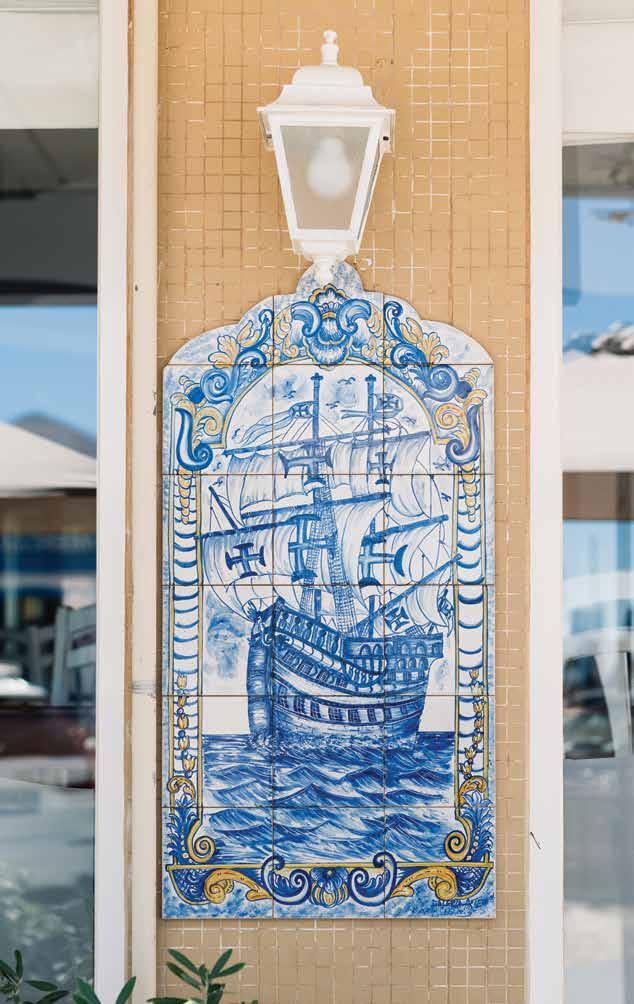
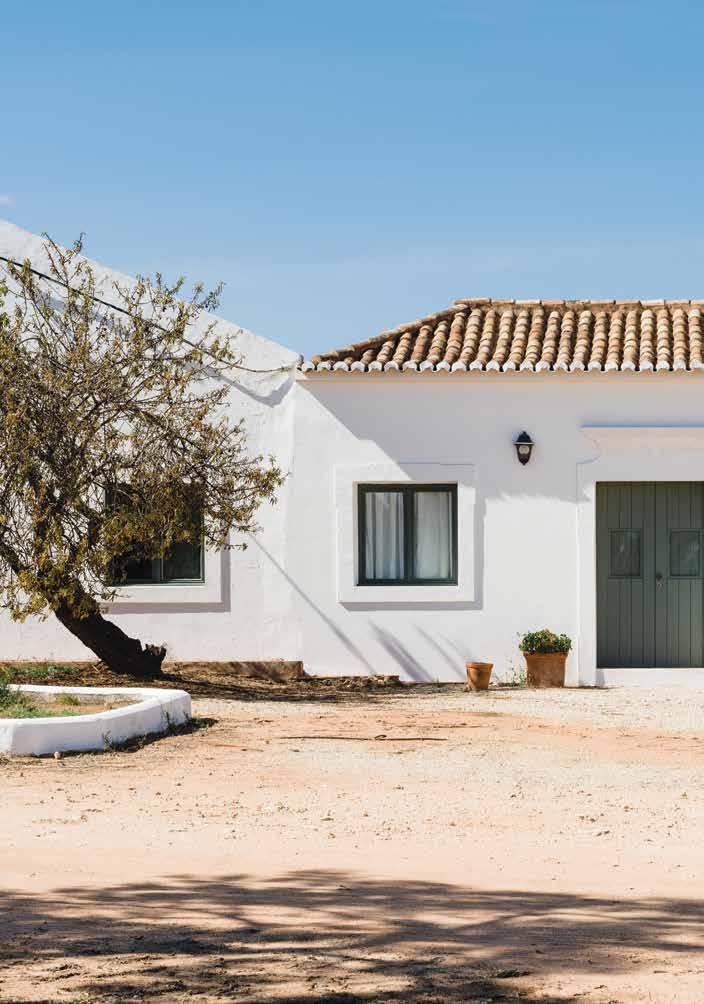
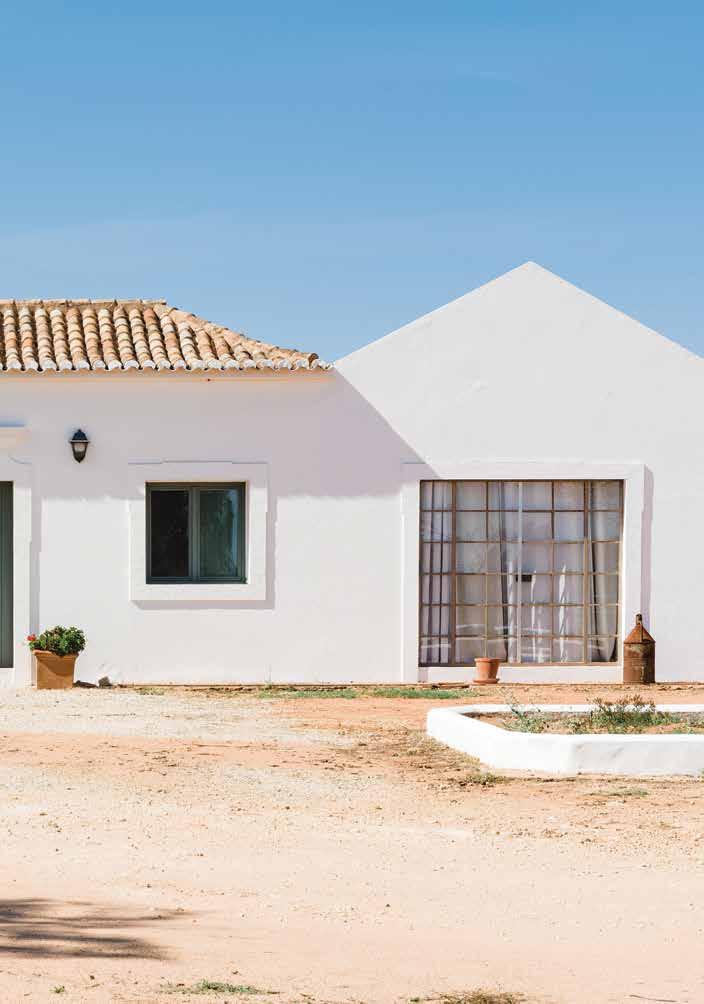
A pass over that first cliff led to two choices. Sometimes we crossed the beach to a second set of cliffs and repeated the climb up a small hill to walk in the forest atop beach cliffs. Other times, we headed inland, past the Foz do Almargem lagoon, high with water in the spring, a nesting ground for herons, waders, ducks, and seagulls.
Continuing past the lagoon, we came into farmland (the small-scale, family-garden type), where homes had orange trees heavy with fruit, flocks of squawking chickens, and one particularly lovely herd of goats. I had always thought of Quarteira as concrete and high-rises; it was a surprise that bucolic nature was so close by.
As the days got longer, the rain became more rare, and I grew fond of Quarteira. I collected fistfuls of wild daisies on my walks—they grow like weeds—and put them around the apartment in empty pasta sauce jars. I collected lemons from my boyfriend’s parents’ tree, squeezed lemonade for lunch, and took thermoses full of lemon-peel tea to an empty spot above the beach to watch the sunset.
Six months after my first Quaranteira stint, when all of Portugal was (diminishingly) open but subdued, I went back to Quarteira as autumn turned to winter and Portugal moved toward its second lockdown. And I watched the same seasonal changes in reverse.
One afternoon around the winter equinox, walking home from having a drink at a beach
bar in the transition zone between gritty Quarteira and pretty Vilamoura, I took the photo that will forever sum up my pandemic Christmas: In it, people are waiting, socially distanced, in front of a churro stand on the Calçadão, the sky on fire with the early sunset in the background. It was beautiful and lonely, and exactly the place I wanted to be.
Belatedly, I started exploring the old parts of the city, away from the water, where a dense thicket of streets wrap around one another, and small old houses are lined up side by side. I found a few buildings to like, but I was initially underwhelmed.
Once, during a disagreement with my boyfriend, I told him that I just wanted to see something beautiful made by humans. He said he didn’t know how he could help, because that’s too subjective—who’s to say what’s beautiful? I thought it was his way of not admitting that there was nothing lovely to see. Looking back on it now, I understand that he was right.
Lisbon is showy, classically beautiful from every angle. In Quarteira, you have to pay attention. The new condo buildings seem generic, but then I found one that has fantastically geometric, crisscrossing exterior staircases, and another one with round windows and blue railings, with a palm tree in front, that would make sense in Miami Beach. In the old city, the boxy little houses were often undistinguished—except for those covered in colorful azulejos, Portugal’s famous tiles, a moment at almargem beach next spreads : scenes at morgado do quintão ; forte novo beach ; calçadão ( the promenade fronting the ocean ).
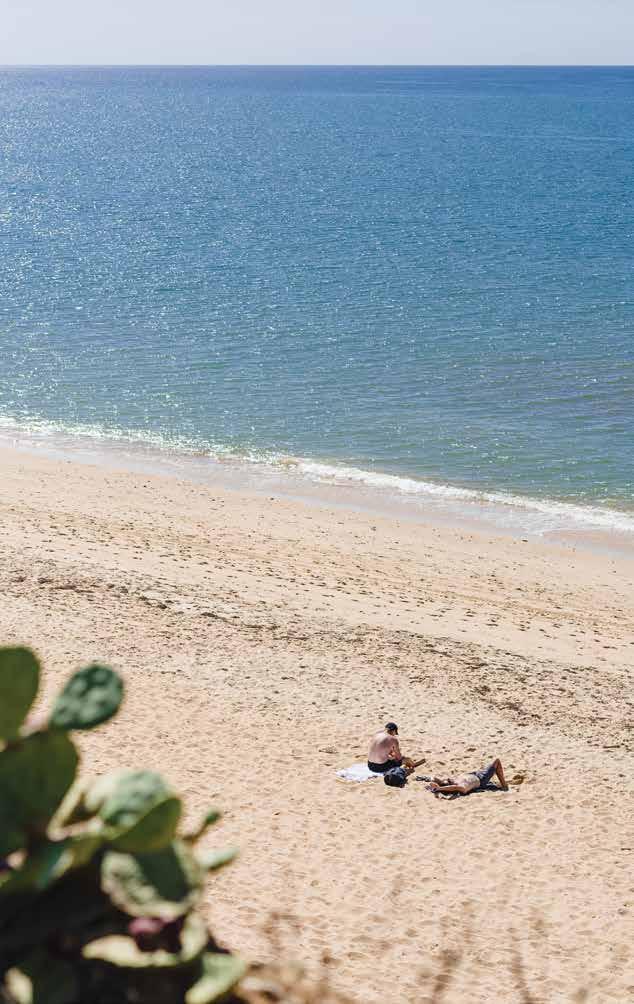
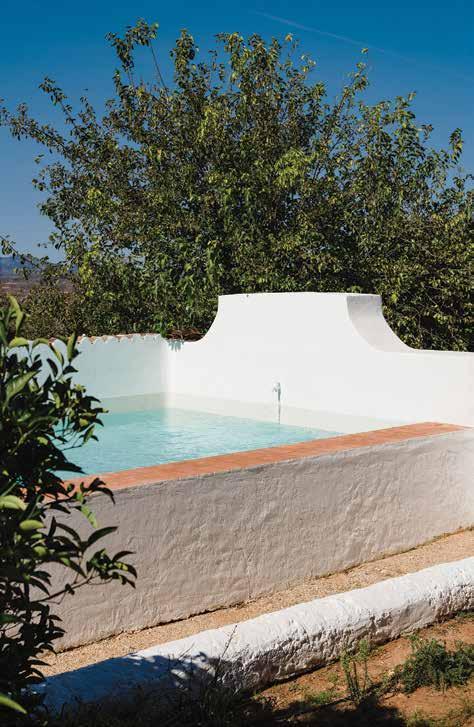
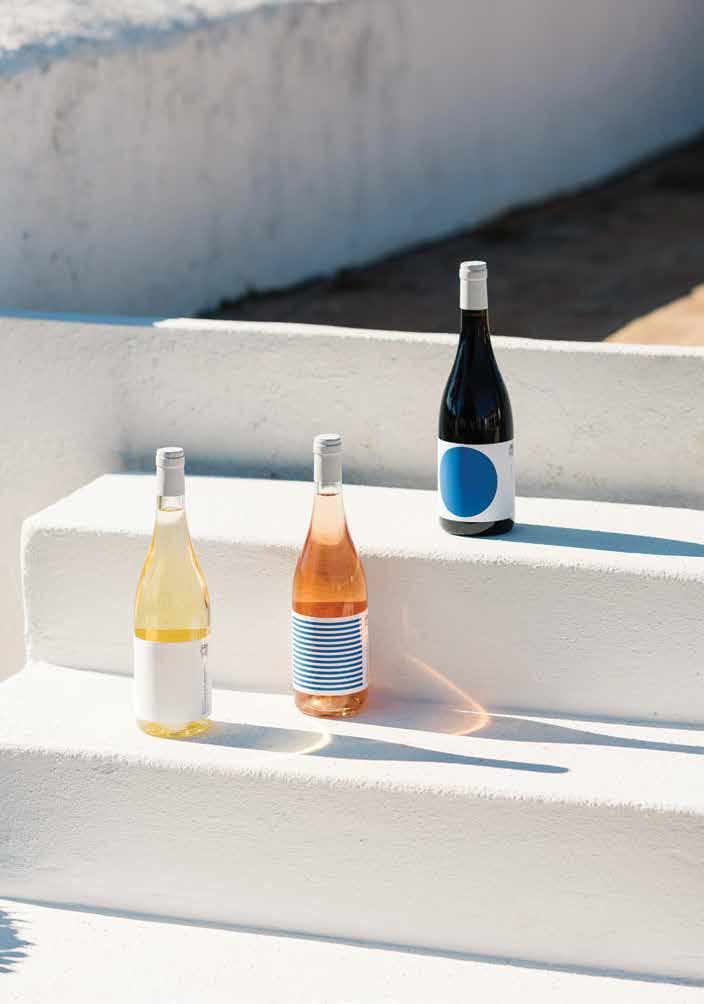
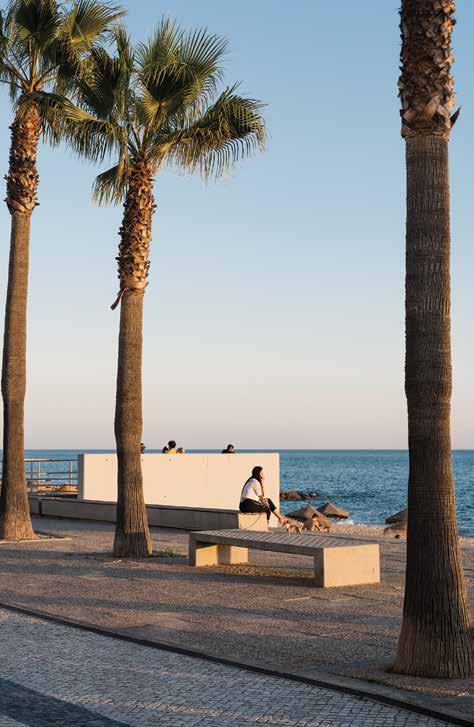
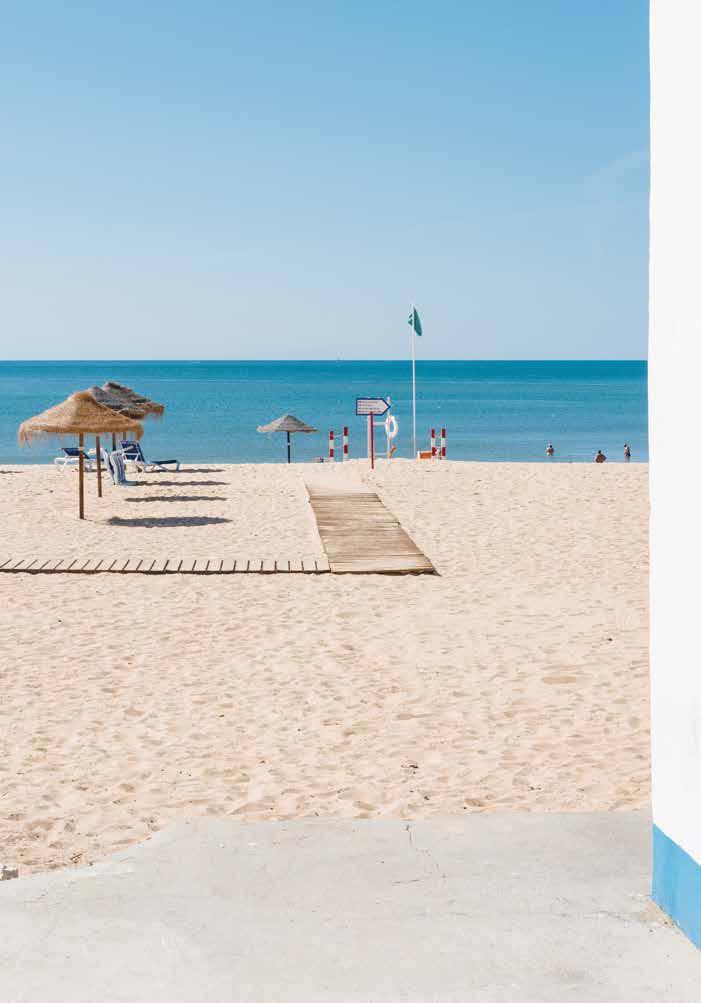
in an exuberant display of pattern-on-pattern design. On top of the church of Our Lady of Conception, in the oldest part of town, the storks’ nests are magnificent.
While it took some time for me to see the beautiful things made by humans in Quarteira, it was a lot easier to fall in love with the delicious food made by humans. Along with the long walks, my other ritual was going for lunch at the vegan restaurant Raízes, sitting outside during the open times or taking Tupperware during the lockdowns. It has an ever-changing menu of daily dishes, some based on Portuguese classics like tofu à Brás, and stewed fava beans with faux sausage.
Another long walk led me to Social, a wine bar and restaurant on the far side of town with small plates and a fun Sunday brunch with live music. It and Coral, another wine bar, became the places we would go when we were in the mood for tapas and wine. At a time when it was still tricky to travel between districts, they reconnected me with Algarve wines whose makers I had visited in the before times, such as the lovely red blends from Convento do Paraíso and Cabrita Wines, both about an hour away in Silves. They also introduced me to new ones. Not long ago, I ventured out to try one of those at the source, the palhete (similar to a rosé) from Morgado do Quintão, which is about an hour away near Lagoa, where tastings are held beneath a 2,000-year-old olive tree.
We celebrated my pandemic birthday in December with a quiet lunch on the sidewalk in front of A Caravela, a longtime spot known for the high-quality fresh fish that
you would expect, given its location across from the fish market. And we celebrated the return to near-normalcy this past summer with a feast of octopus salad, conquilhas (tiny clams) with bulhão pato sauce (lemon, coriander, and tons of garlic), and razor clam rice at Tico-Tico, a longtime favorite of locals, which used its time off to move from its tiny location in the old town to a prime beachfront spot.
In Quarteira, the main evening activity is promenading along the Calçadão. Some restaurants along the way have live music and a smattering of dancing. Last summer, a string of Brazilian bars sprung up, complete with DJs and live performers—which brings me to another selling point for Quarteira. It’s been multicultural for decades, a mix of Portuguese, Brazilians, Africans, English, Eastern Europeans. Everyone feels welcome.
I’m not planning on trading in my big-city life in Lisbon. And sure, I love the postcardperfect little fishing Algarve villages where my Lisboeta friends—those same ones who were mystified by my affinity for Quarteira— like to go for holidays. But the last time I was in Quarteira, it was a hot summer night and the Calçadão was full of people, walking, dancing, eating ice cream, and sipping caipirinhas as midnight came and went. Kids zoomed past on bicycles. It was the opposite of the quiet nature that I’d fallen in love with months earlier, a mixture of loud beats and languages. Quarteira, I thought, will never be boring.
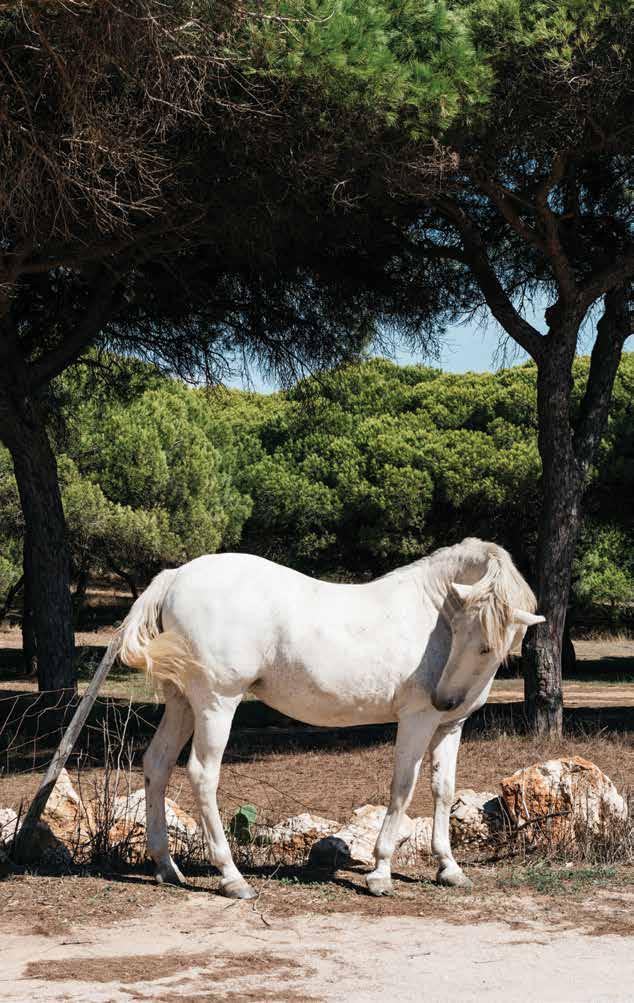
Artist in Residence
Remnants of the artist Jean Charlot still haunt the home. Past a series of cantilevered steps within what was once his studio are pinprick indentations along a curved cork wall, which Charlot made when he pinned up drafts of his famed murals. Ambling through the historic property, I stumble upon tiles of handpainted petroglyphs inlaid in the floors, walls, and beams like Easter eggs of artwork hidden throughout the structure.
Then there is the home’s pièce de résistance: Above a set of sliding glass doors that lead to the lānai is a fresco spanning the length of the living room. Native flora and tropical plants painted in the Aubusson style, a burst
of thick foliage in verdant shades of green, fill the scene. It was completed by Charlot with the assistance of renowned Hawai‘i artist Juliette May Fraser, making it the first artwork to decorate the home—and the last. In the years since the home’s vacancy, when most of the art and books and personal memorabilia have been emptied out, this is among the final to remain.
From its completion in 1958 to Charlot’s death in 1979, this historic property in the quiet O‘ahu suburb of Kāhala was where the celebrated artist lived, played, and worked. Today, it is owned by the University of Hawai'i and preserved in partnership with the Historic Hawai‘i Foundation. Charlot
at this historic modernist property on o ‘ ahu , the presence of
cannot be ignored
artist jean charlot
text by eunica escalante images by john hook and chris rohrer
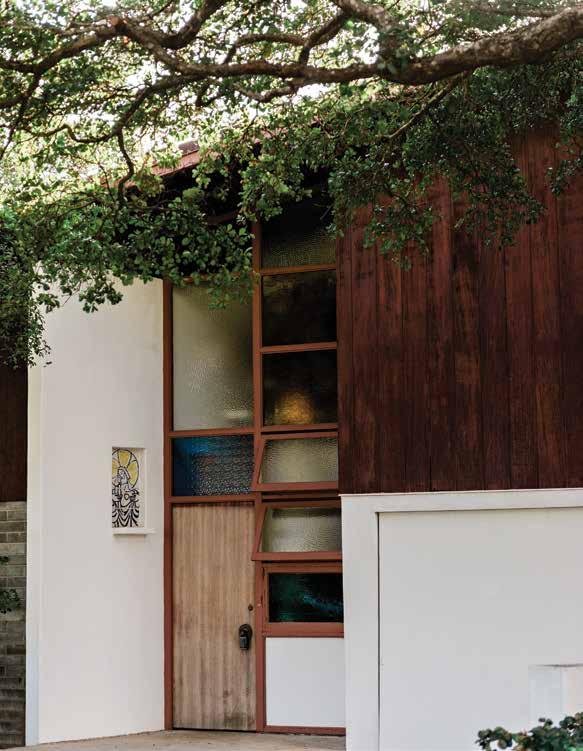
honolulu / design 83
first conceptualized the property in 1957, when a commission from the University of Hawai‘i at Mānoa for a fresco turned into a full-time teaching position in the university’s art department. He contracted noted Hawai‘i architect George J. “Pete” Wimberly to design it, but blueprints Charlot drafted in his sketchbook also show how involved he was in the design process.
There is a story that Bronwen Solyom, the former curator of UH Mānoa’s Jean Charlot collection, likes to tell. To design the color scheme of the stained-glass façade that would surround the entryway, Charlot drew a template. As if an instructor handing out
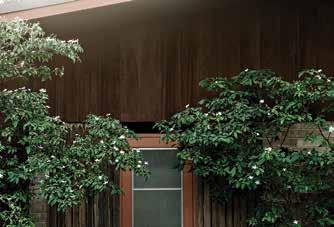
homework, he disseminated it to friends and family to color in. In the end, Solyom says, Charlot settled on his own color scheme of cerulean, jade, and amber. Yet the idea was very much of Charlot’s nature as a nurturer of creativity, especially in others.
The split-level ranch style home is a blend of Charlot’s French and Mexican backgrounds. Its vertical emphasis evokes the French rural architecture of his childhood. The brick floors and spacious back courtyard
are reminiscent of the Mexican homes that Charlot, who was of Aztec descent, inhabited in his early adulthood as an artist working among the likes of Diego Rivera and Fernando Leal.
Yet the home is still uniquely of the Hawaiian Islands, reflecting the sense of place that Charlot often emphasized in his work. There is the wrap-around lānai, a quintessential Hawai‘i design. Natural materials, many of them native, texturize the home, such as the slab wall separating the dining and living rooms which is made entirely of hāpu‘u, the Hawaiian tree fern. It seems like an ordinary wall until a sliver of sunlight streams in, illuminating the countless sprigs crisscrossing its surface. “I don’t think I’ve seen this feature in any other home,” says Daniel Friedman, former dean of the UH Mānoa School of Architecture. “It truly is unique.”
Contrary to his earlier works, which centered human subjects, Charlot’s Hawai‘i phase was stirred by the verdant landscape that surrounded him and inspired by the way Native Hawaiian art symbolically merged man and nature. “Mexico focused on human beings, who carried the main message of an artwork; Hawai‘i focused on an all-encompassing nature,” his son, John Charlot, wrote in an essay examining his father’s relationship to Hawaiian culture. “Rather than the environment and the human community being separate, in Charlot’s mural they form a coherent whole, all bathed in the beautiful local light.”
This coherence of nature and man is evident throughout the home’s design, which blurs the interior and exterior. Floor-to-ceiling glass doors create the illusion of a home with no walls, while natural materials like
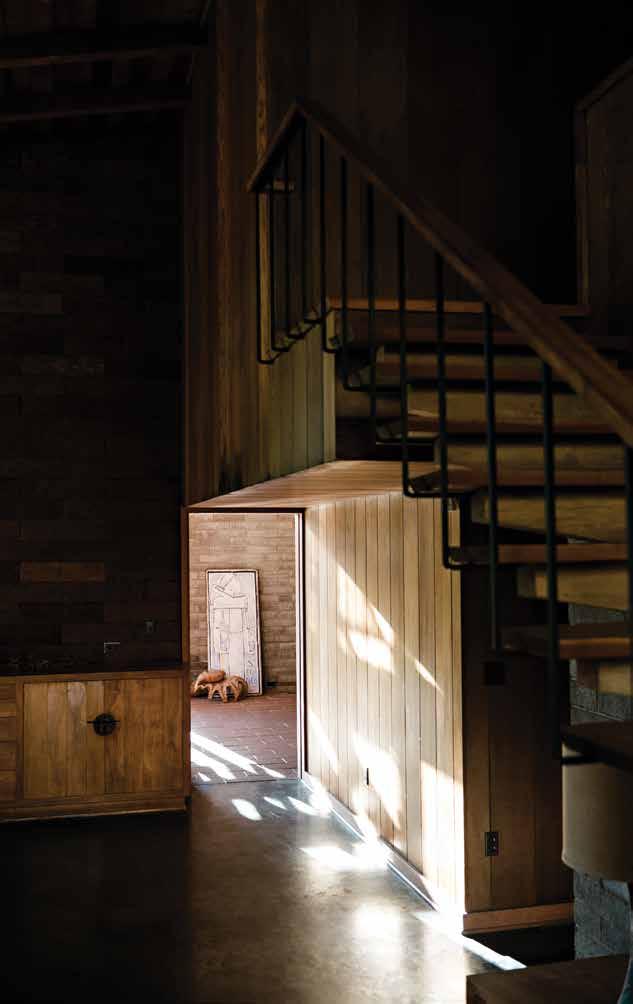
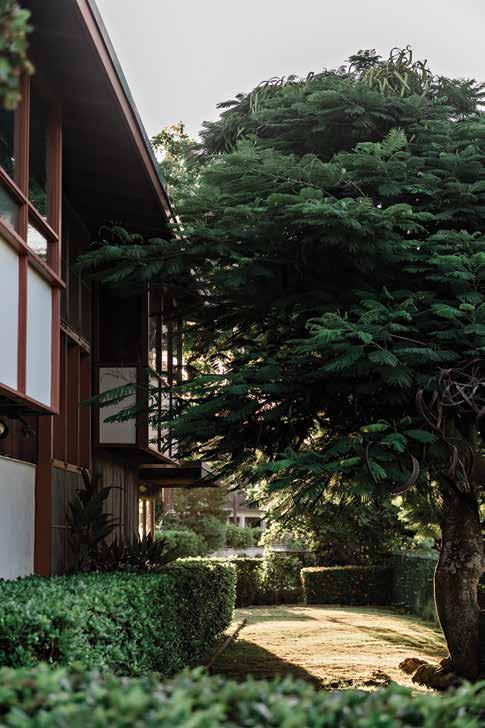
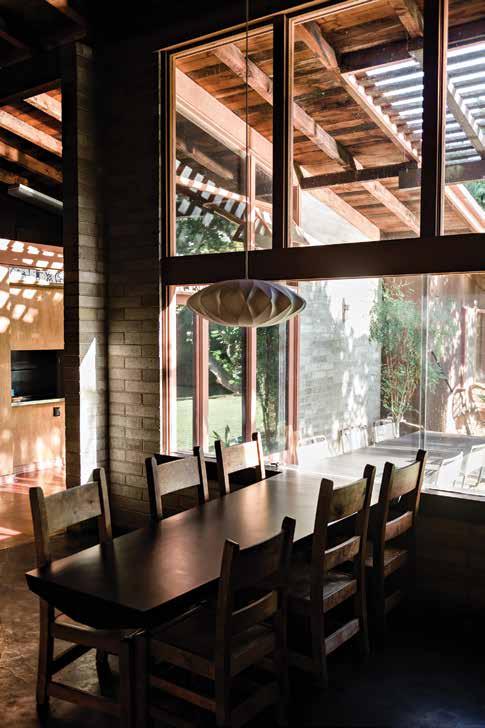
hāpu‘u and ‘ōhi‘a wood bring the outdoors in. The dining table is the paragon of this philosophy. Designed by Charlot himself, the table branches out from the exterior wall, one half in and the other out, the delineation made by sliding glass windows that meet on top of the table’s middle. During the many soirées held by the Charlots, which were frequented by many in Hawai‘i’s intellectual circles (evidenced by the home’s guestbook), the windows were slid open, the congregation transcending the home’s physical barriers. The artist's perspective and innovation now serve as inspiration for UH students.
Walking through the house, feeling my feet atop the hardwood floors where Charlot walked, it is hard to shake the feeling that the artist is still there. After more than two decades living in the home, this was where he spent the last of his days in March 1979. Six months earlier, he completed his last mural, for Maryknoll Elementary School, part of the many public art works he did for the state.
“Charlot pops into people’s lives in so many different ways—be it through a mural at their old school or a print they’ve discovered,” Solyom says. “It’s inspiring to know he’s touched so many people.”
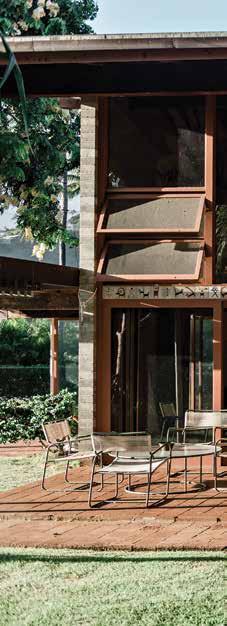
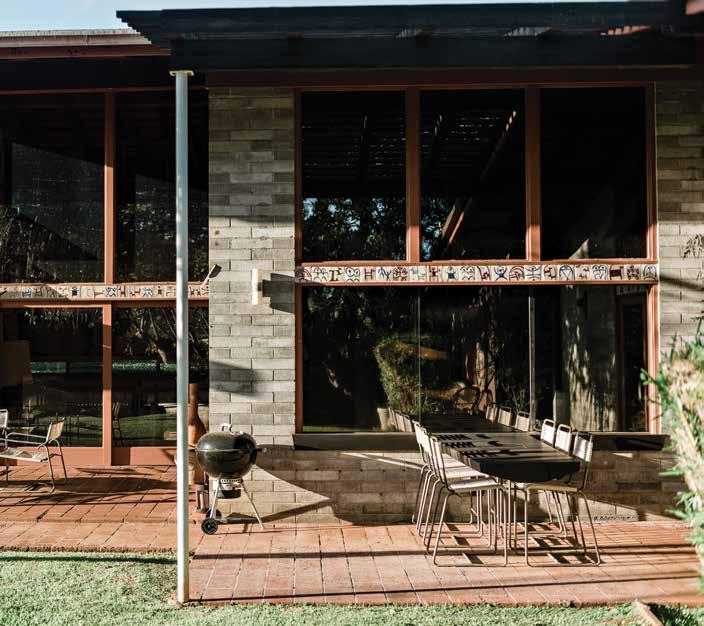
89
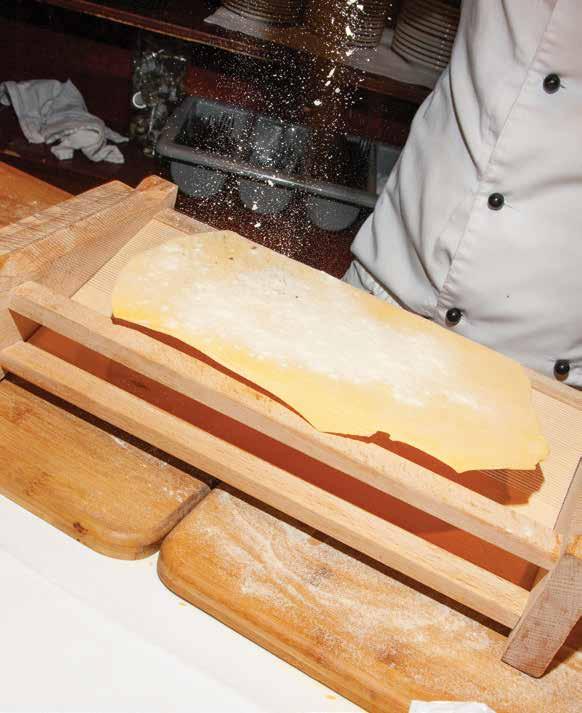
boston / culinary 90
boston restaurants offer opportunities for immigrants to build community and speak through dishes and desserts about the nuances of their home countries and cultures


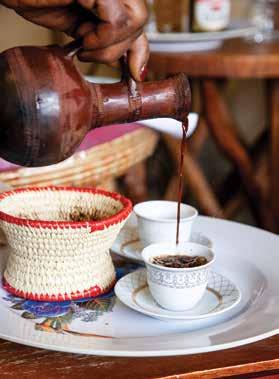
Breaking Bread
homes and build new communities
By the time chef Letensae Afeworki was 12 years old, she had mastered the art of communal cooking. Before becoming an executive chef and restaurant owner in the United States, she was a girl growing up in Asmara, the capital of Eritrea, a northeast African country colonized by Italy from 1882 to 1941. Much of Afeworki’s childhood was spent refining her palate
text by c hunter zuli images by pj couture
ristorante lucia , eldo cake house , and asmara restaurant in boston share distant
and learning how to cook Eritrean and Italian dishes from her mother, who trusted her pre-adolescent daughter’s culinary talent enough to step aside and allow her to independently prepare, cook, and serve community meals.
When Afeworki emigrated to Cambridge, Massachusetts in 1981, 10 years before Eritrea gained its independence from Ethiopia, news of her arrival quickly spread among the small, eager, and hungry Habesha community living in the Boston metropolitan area. She spent years feeding folks from her home and earned a reputation as a top East African cook before opening
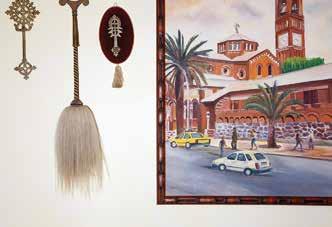
the doors of Asmara Restaurant in 1986. Asmara was the first African restaurant in Central Square, and it garnered lines down Massachusetts Avenue for the cuisine which Afeworki cooked, and still cooks, without a single recipe, spoon, or measuring cup.
Thirty-three years later, Asmara Restaurant has become the chef’s Cambridge community dining room, with customers from all backgrounds treated as if they are her kin. “This is my home. This is my
kitchen,” she told me. “And it makes me happy when my customers feel as if they’re my best friend.” Some regulars have been frequenting Asmara Restaurant since she opened the place, she said. Her customers come for daily meals and special occasions— first dates, marriage engagements, weddings, new children, graduations, and college orientations. They call her “Lete,” and she calls them her children.
In 1993, when I was 7 years old, my father, a Congolese immigrant, brought me to eat at Asmara Restaurant for the first time. He chose to sit at one of the traditional dining areas available: a small end table for drinks accompanied by chairs surrounding a mosob (Eritrean dining basket). When our food came out, it was served on a large family-style platter that was placed in the mosob, with heaps of begeeh mloukhiya (lamb curried with red pepper sauce), fluy tibsy (tenderloin tips), shuro (stewed chickpeas), bersen (lentils curried in pepper sauce), hamli (collard greens), and their juices soaking the injera (teff-flour based sour bread) underneath it all. There were no utensils, and we were guided to scoop up our food with our hands using the injera, something that thrilled me as a second grader.
To this day, the menu includes two paragraphs about the restaurant’s history and Eritrea’s cultural relationship to Italy, something many customers didn’t know about when the 1986 menu debuted with both Eritrean and Italian dishes. Back then, when customers scoffed at the “authenticity” of the dishes like lasagna and spaghetti, Afeworki responded as she would to any friend: She gave free samples and shared Eritrea’s unknown history with customers.
Boston has a history of welcoming transplants. East Boston’s now-closed
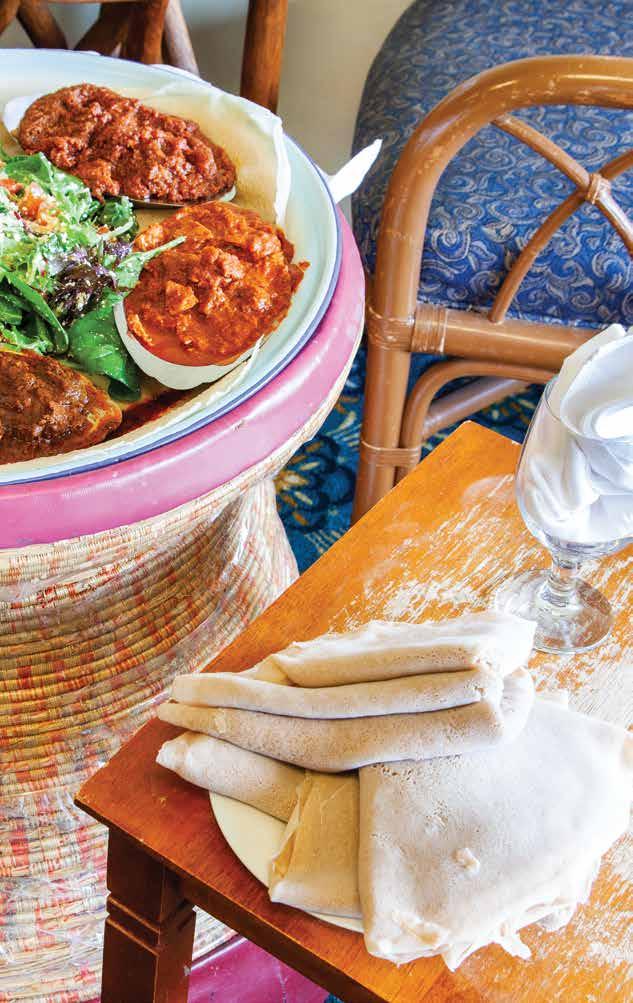
immigration station was built in 1920 and became the largest port of entry in the United States, second only to Ellis Island. Since the city’s influx of immigrants began in the 1800s, folks of Irish, Italian, West Indian/Caribbean, and Chinese descent have become the largest four ethnic groups in Boston, with immigrants from Cape Verde and other African countries following suit. With language and accents often barriers for newly arrived immigrants, the menus and physical environments of their businesses offer opportunities to speak through their food about the nuances of their home countries and cultures.
Filippo Frattaroli arrived in East Boston from Sulmona, Italy in 1970 as a teenager with a fierce commitment to share the tastes and experiences of his Italian Abruzzo culture. After working odd restaurant jobs, he used a combination of savings and inherited money to open Ristorante Lucia in 1977, named for his mother, whose recipes are scattered across the menu. Abruzzo specialties like carrozza (breaded, pan-fried mozzarella stuffed with prosciutto and served with marinara) are listed alongside more familiar antipasti such as calamari, bruschette, and scampi. Regional dishes include scaloppine Abruzzese, which is veal and chicken sauteed with butter, white wine, broccoli, and cheese tossed with penne rigate and chitarra al tartufo, which includes wild mushrooms and sausage served with fresh white truffle
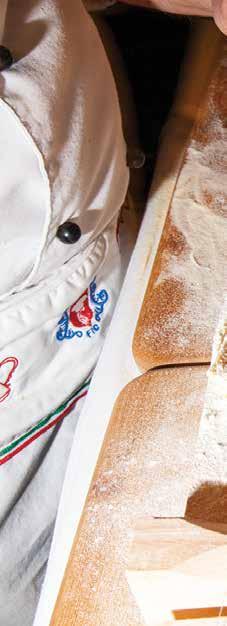
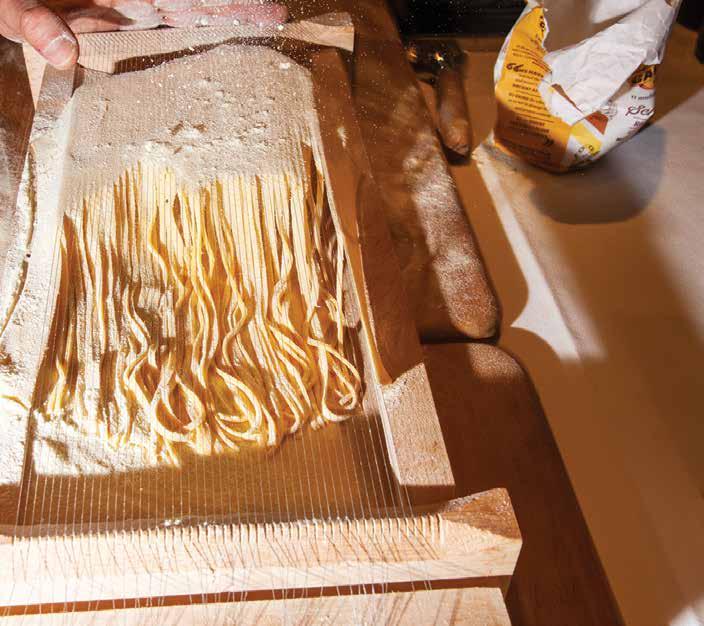
95
oil straight from a Frattaroli-owned truffle farm in his hometown of Sulmona, Italy, which he purchased in 2019.
In Chinatown, Eldo Cake House’s green awning invites you into a small, unpretentious bakery that has been serving savory and sweet Chinese pastries for more than 30 years. Its cases feature desserts like lotus paste with preserved eggs, steam buns, chicken pie, roast pork turnover, egg tart, coconut tart, assorted cakes, and even apple pie. Here, where three pastries can cost $5 or less, you’ll find a community built through affordability; regulars of all ages and backgrounds visit Eldo.
At Highland Creole Cuisine in Somerville, a no-frills Haitian restaurant opened in 1993, staff proudly speak Kreyol and its Sunday special of soup joumou is a history lesson in food form. Typically eaten in celebration of Haitian Independence Day (January 1, 1804), the squash soup includes ingredients that enslaved Haitians were banished from consuming. Abundant with various root vegetables, meat, and noodles, joumou is the country’s freedom soup. In many respects, serving it to the masses on a weekly basis represents the freedom to break tradition and create new norms with new neighbors in a new country.
The hyphenated American, or immigrant, experience is one of multiple consciousnesses: knowing where you came from, where you’ve landed, and where you hope to go. Home is
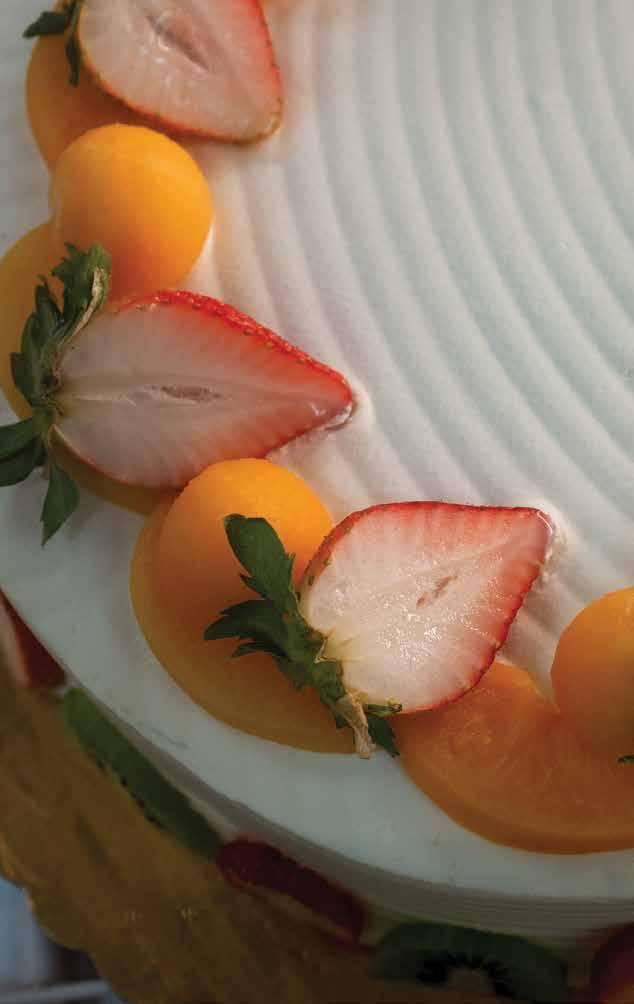
wherever you are, and your tribe are those who honor what you bring to the table, no matter what language you speak. You seek opportunity in hopes of being accepted for who you are and where you’ve come from, and in turn, aim to cultivate the same feeling for others.
Twenty-seven years later, the menu at Asmara Restaurant is as I remembered it, exclusively featuring an Eritrean spread of poultry, lamb, beef, seafood, vegetables, and house salads using 27 spices and ingredients, including berbere, a spice mixture that is a common ingredient in many Ethiopian and Eritrean dishes. The art on the walls portray scenes straight from Asmara: a blown-up photograph of Kombishtato, also known as Independence Avenue, and vibrant Eritrean paintings on animal-hide canvases portraying women weaving mosobs, making injera, and of course, eating communally.
“We have great people that come here that are excited, happy, willing, and open,” says Saba Afeworki, manager of operations at Asmara Restaurant. “Everybody’s family. Even if you’re not blood-related. This is a safe space. No one’s here to judge you.”
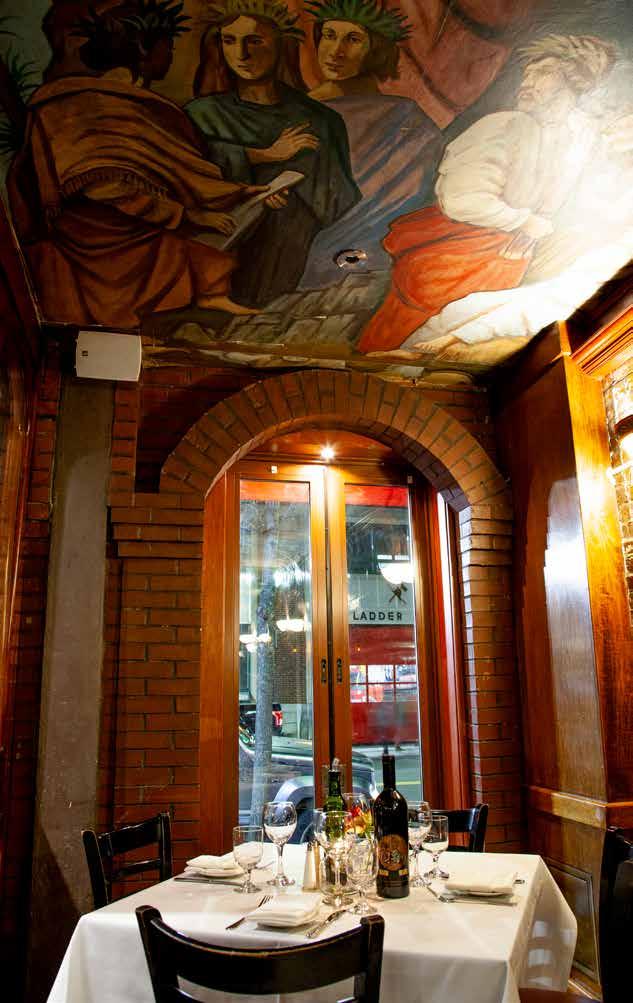
ahead
A catalyst for departure
boston / deer valley / hawai ' i / los angeles / miami / new york / portugal / turkey image by rodrigo cardoso

101
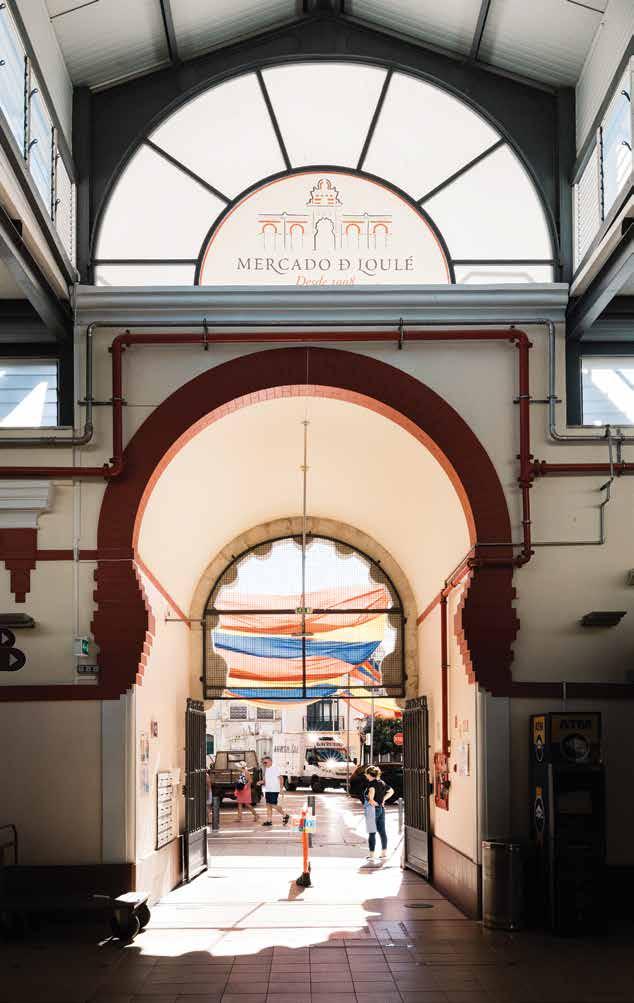
get to know dino d ’ santiago , arguably the most famous musician from the algarve , and learn a few of his favorite destinations in the region .
Hometown Hero
meet and greet
103

In 2010, Dino D’Santiago went with his father to Santiago in Cape Verde, the island from which he took his stage name. There, he connected more deeply with the soul of the Cape Verdean music that he had grown up with at home. He was already an accomplished musician, but since that trip, his sound increasingly fused traditional morna, batuku, and funaná with contemporary club music and R&B.
Although D’Santiago now splits his time between Lisbon and his hometown of Quarteira, Quarteira remains in his soul.
D’Santiago’s father came to the city in Algarve from Cape Verde in 1972, shortly before the islands achieved independence from Portugal. His mother joined his father there in the early 1980s, and he was born in 1982. The musician grew up in the Bairro dos Pescadores (the fishermen’s neighborhood) and started singing with his family in a church choir.
portugal / profile
text by ann abel images by rodrigo cardoso
the mercado do loulé ( previous spread ) and restaurante la cabane ( right ) are two of dino d ' santiago ' s algarve favorites .
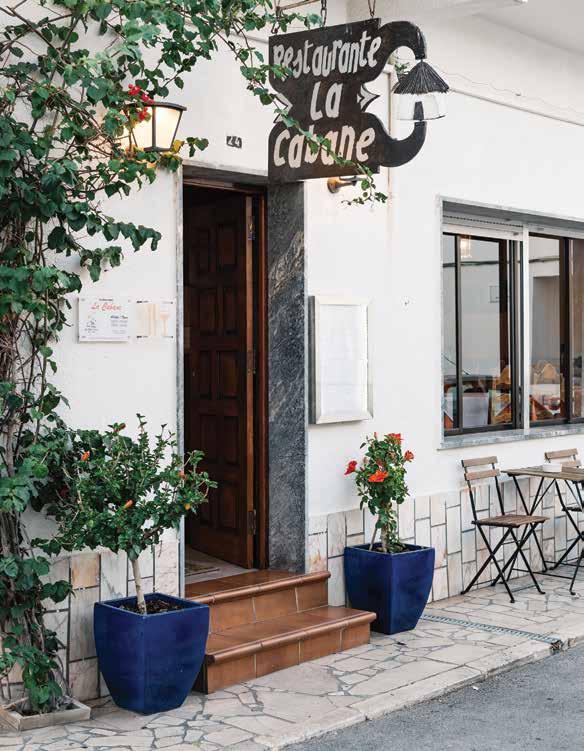
105
“It was a hard time because a lot of people were coming from Lusophone [Portuguese-speaking] Africa,” D’Santiago explains. “Quarteira had a bad image around the country because Bairro dos Pescadores was like a favela, really poor with a lot of acculturation.” At the same time, as more immigrants arrived, the city continued to grow. “People worked in construction or domestic work,” he recalls. “Quarteira was almost the city of the workers, the one that supported the construction of Vilamoura, Vale do Lobo, and Quinta do Lago, the diamonds of the Algarve.”
His singing talent gained him the attention of rappers, who needed a singer for hooks. At the age of 21, D’Santiago left home to pursue a career in music, singing with hip-hop and R&B acts. After his trip to Cape Verde, he developed the signature style that has garnered him national and international recognition, and even the attention of Madonna after she moved to Lisbon in 2017. (He coached her on speaking and singing in Portuguese and Creole and appeared on her album Madame X and beside her onstage.)
Through it all, he has remained a proud champion of Quarteira, a coastal city that is sometimes misunderstood. In the 1990s, as immigrants kept arriving, he says, it was a “really urban city,” with influences of street art, hip-hop, graffiti, sports like BMX, surfing, basketball, and breakdance. “It had mixed culture, an
 d ' santiago recommends visiting castelo de silves in silves , which has a lengthy and layered history .
d ' santiago recommends visiting castelo de silves in silves , which has a lengthy and layered history .

107
African side with kizomba and funaná and also a hardcore movement with Nirvana, Green Day, and the Offspring. And then in the early 2000s, people came from Brazil and Eastern Europe, and they combined like feijoada—Quarteira is a big feijoada mixed with cachupa,” he says, referencing Brazilian and Cape Verdean stews.
Now D’Santiago is using his cultural influence to celebrate Quarteira. He produces Sou Quarteira (“I am Quarteira”), an annual international festival featuring artists like Mayra Andrade, Eva Rap Diva, and Branko. But to D’Santiago, Sou Quarteira is “more of a movement, to share to the world the talents from Quarteira, what we are doing in medicine, sports, hotels, big chefs. Like a transversal way to see how a city that was stigmatized over the years, how we are reinventing ourselves to show that we are the epicenter of the Algarve.”
The city’s multiculturalism is an important piece of that. “When I travel to New York, London, or São Paulo, it’s not strange to see diversity. That’s what Quarteira has. There were 37 nationalities in my school. It’s normal for me since I was a kid. That’s how I learned to speak English, French, and Creole, just talking with people from different cultures and perspectives.”
The city loves him back. The president of the municipality awarded him a Gold Medal of Honor in 2020, and that same year, a mural of D’Santiago and his son by the artist Menau went up near the city hall. “For me, it’s like, ‘Wow,’” admits D’Santiago. “It was done because of the [Black Lives Matter] march in Lisbon, someone took this picture of me with my son Benjamin on my shoulders. This kid is looking for a changing world. I hope in his lifetime he will see the changes that we need.”
at la cabana restaurant in quarteira
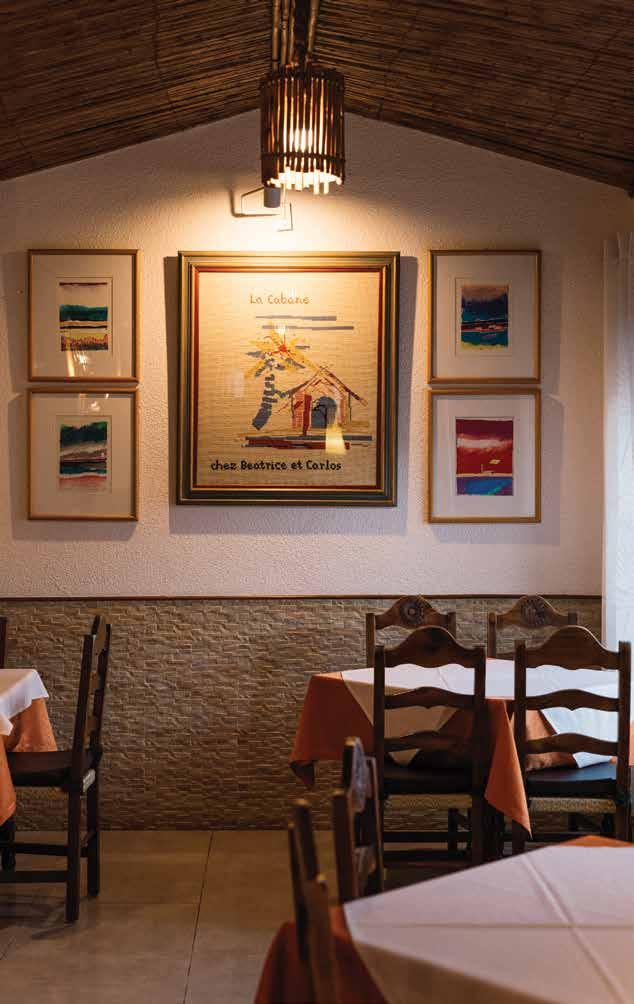

the algarve favorites of dino d ’ santiago
La Cabane, Quarteira
Old-school, no-frills Portuguese restaurant away from the beach with a devoted local following
Mercado do Loulé, Loulé
Regional food market with local vegetables and delicacies in a historic building
Ilha Deserta, Faro
Nearly deserted island (save for a very good fish restaurant) reached via boat trip from Faro
Castelo de Silves, Silves
Castle with more than 1,000 years of history, and one of Portugal’s most notable examples of military architecture
Noélia & Jerónimo, Cabanas
One of the top casual restaurants in the Algarve, a favorite of chefs
Praia de Cabanas, Cabanas

A particularly beautiful beach within the Ria Formosa natural park
Praia da Falesia, Albufeira
Stunning beach in the central Algarve distinguished by its ochre-hued cliffs
Castro Marim
Picturesque, historic village near the Spanish border
Lagos
Lively town on the western edge between the surfers’ Algarve and the golfers’ Algarve
Dom Pedro Pinhal Golf, Vilamoura
The Quarteira kid made it to Vilamoura in the end
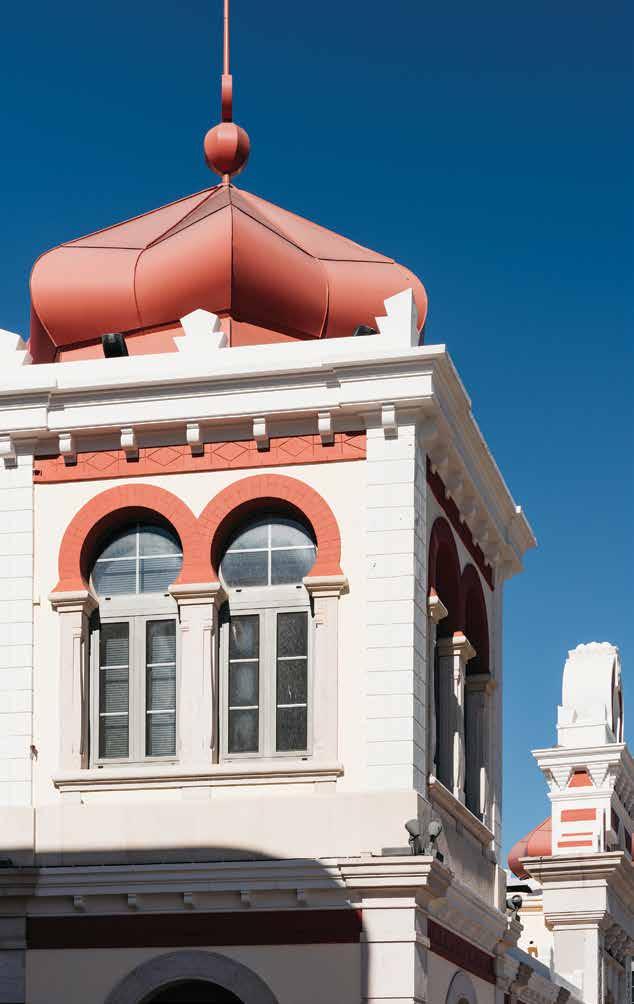
On Bluebird Days
Abluebird day begins in the predawn hours, under the tailings of a blizzard. A fire, breakfast burritos, and hot tea coax the body vertical. On the drive to a cherished ski hill, resort, or backcountry trail, the skirt of the storm begins to lift, revealing a fresh layer of snow that rests on the landscape like a blank word-processing document. The whiteness persuades even the most hesitant of writers to journal and punctuate the page with anything from early morning ennui to nonsense exclamations like yippee! and yahoo! before signing it with the sweeping signatures of ski turns.
The storm dissipates while riding first chair or skinning up steep slopes. The sky lightens from a darkly nautical blue bedazzled with a handful of early morning stars to a rich robin’s egg hue. Soon, the winter sun summits a far ridgeline of mountains and slingshots its rays across the facets of the top layer of snow, turning the entire mountain range into a disco ball. From the top of the lift, faraway valleys give way to horizons framed by other ranges. Descents through glades and bowls on Rocky Mountain “champagne” powder give the feeling of flight—a little bluebird of happiness.
an ode to wondrous conditions following a day of snow , from the u s west to wintry slopes around the world text by miles w . griffis images by brett briggs
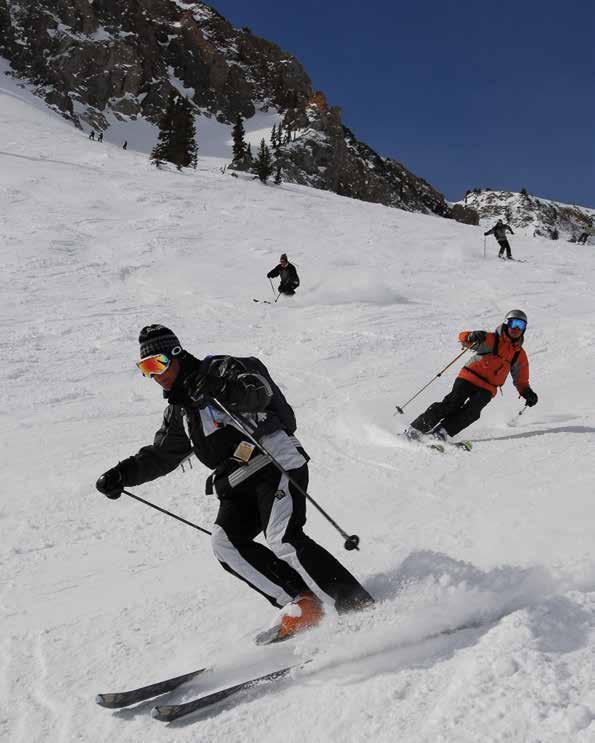
deer valley / destination 113
Merriam Webster dates the first known use of the phrase “bluebird day” to 1860 and defines it as “a day marked by cloudless blue skies.” Other definitions specify that the phenomenon typically happens after a night of snowfall. The phrase has been used for decades by skiers, snowboarders, hunters, anglers, and others to connote the happiness the sun ignites on a winter day, most commonly in the American West. (It can also be heard across North America and around the world, uttered by snow sports enthusiasts who encountered it in North America.)
Others believe the phrase comes from the feeling of joy that the bluebird—three

thrushes from the genus Sialia including western bluebirds, mountain bluebirds, and eastern bluebirds—brings when it ignites our meadows with tiny fireworks of sky-blue feathers. Numerous cultures across Europe and Asia have deemed the bluebird a bringer of joy and hope. In the Southwest, the Diné (Navajo) say the bluebird is “the image of a god, the herald of the rising sun.” The Cochiti say that the Sun once impregnated a woman, and that they named their firstborn Culutiwa, or Bluebird.
In Colorado, my mother keeps a journal of the first mountain bluebirds she sees as they return in spring amongst seas of sage and rabbitbrush. She tells me she looks forward all winter to their cheery homecoming. Wrote poet Joy Harjo, “Birds are singing the sky into place.”
Backcountry skier Beth Lopez of Salt Lake City, Utah, has chased hundreds of bluebird days across the Rocky Mountains in her quest for the perfect line. “The sun is my saving grace and my holy grail,” she says, describing the frostbite damage she’s acquired from various ski touring trips. “I wait for it to come out, it’s my heater that saves me.”
A writer and ski ambassador for brands like Arc’teryx, Lopez is working on skiing all 90 lines in The Chuting Gallery: A Guide to Steep Skiing in the Wasatch by Andrew McLean, which have been completed by only one woman—professional skier and climate activist Caroline Gleich. The guide has become a lifelong checklist for many Salt Lake City-area backcountry skiers. Some consider it a Holy Grail of experiences in Utah’s towering Wasatch Range, running 160 miles long and cresting at 11,928 feet. Within the guide are chutes named Heart of Darkness, Hellgate Couloir, and The Hypodermic Needle. Lopez notes she doesn’t typically share this goal publicly, but hopes that in doing so she’ll inspire other female athletes to take on the endeavor. So far, she’s completed 60 of the 90 chutes.
“It’s funny how you can get flummoxed,” she says. “The average line [in The Chuting Gallery] can take several attempts to complete because the conditions may not add up, your gear breaks, or the weather turns.”
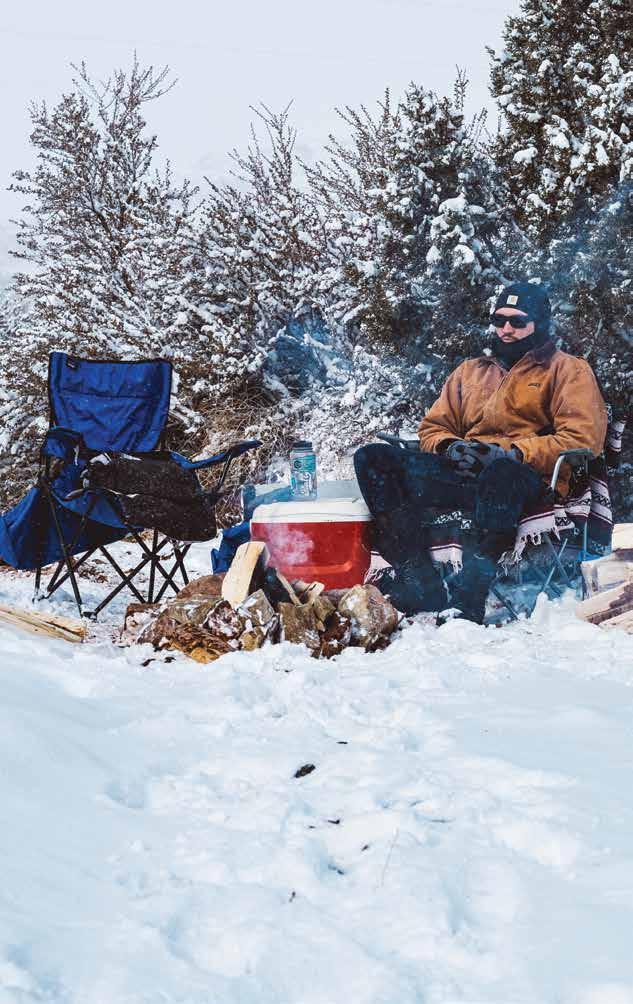

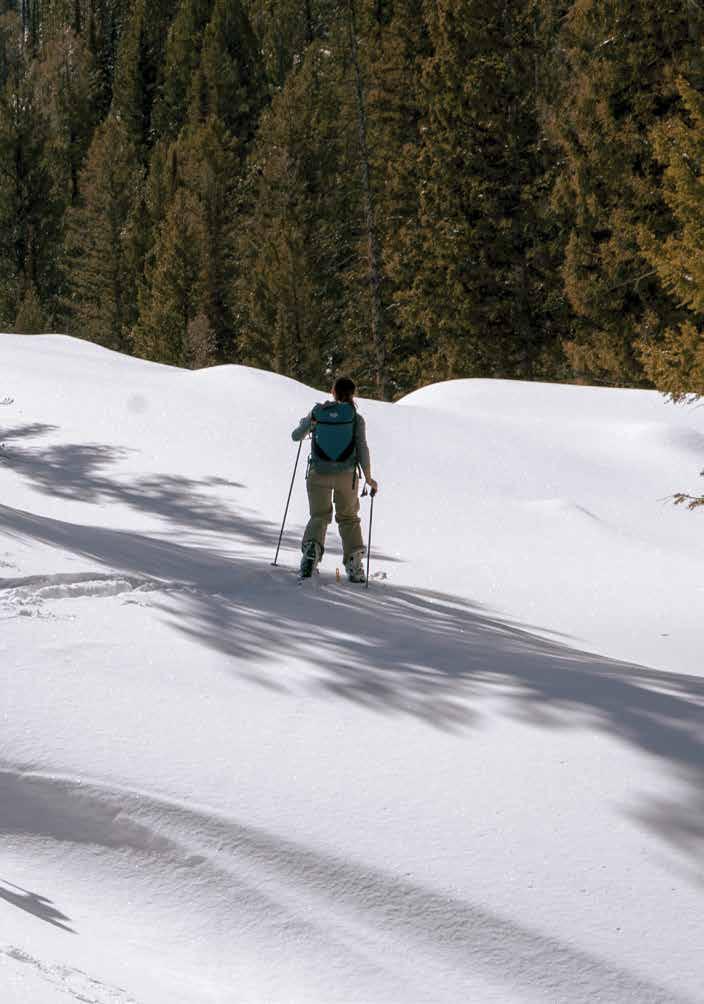
In the backcountry, predicting safe, skiable conditions is a science with hidden variables. Lopez uses avalanche forecasts, mapping, sun positioning, and other snow tests to lessen the risk of avalanches and fatal falls during backcountry ski tours—but even these careful observations can fail skiers and put them in danger, like the unpredictable pocket of gelatinous snow that once caused Lopez to tear every ligament in her knee and bruise her femur. “The sun is a fickle mistress,” Lopez says. “She can either give you perfect soft snow or send you into survival mode.”
Conditions on the resort are far more predictable. From powder to corduroy, from crud to ice, on-piste skiers—whether skiing the Wasatch, The French Alps, or New Zealand’s Remarkables—are given a consistent menu of snow that we learn to read with experience. Powder is one of the most soughtafter conditions, but in the spring, another anticipated one arrives: corn snow.


119
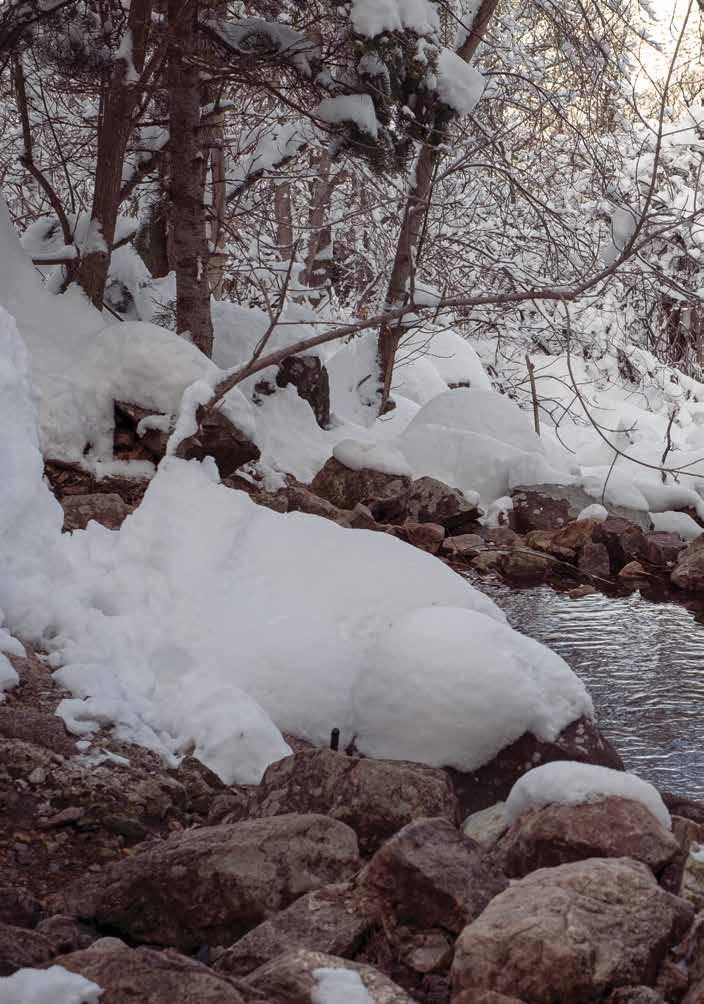
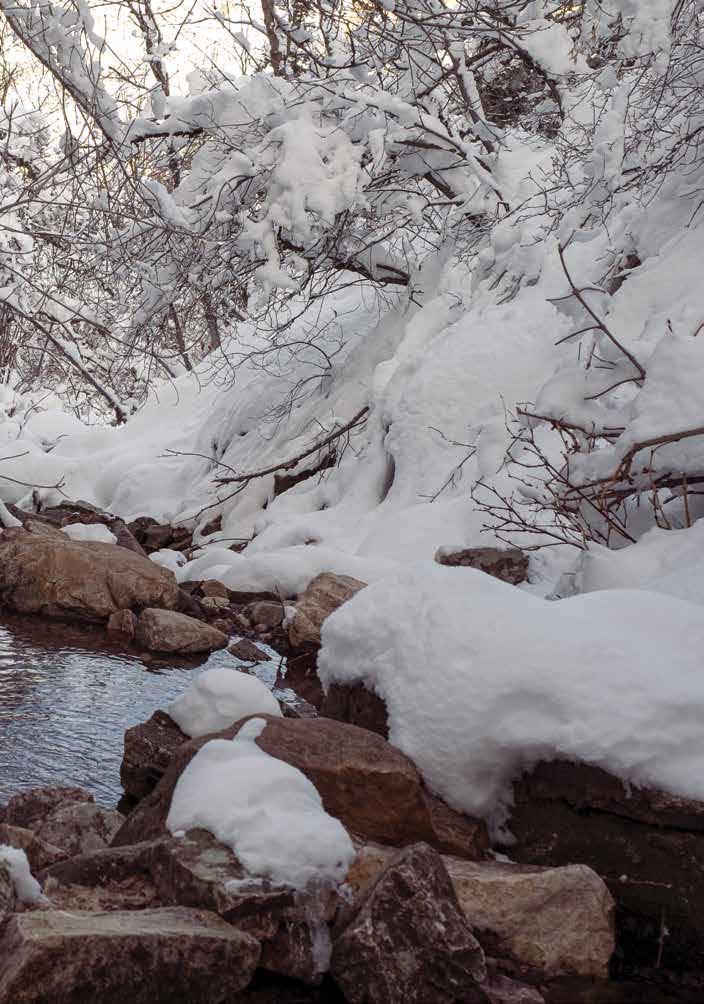
“For an ephemeral hour, there is that beautiful window of corn,” Lopez says, describing the Goldilocks condition of forgiving snow that hasn’t yet turned into a slush from the intensity of a spring sun. Up close, the snow resembles albino kernels of frozen maize. Like bluebird days, corn snow is prized in ski communities around the globe.
Each winter, we form new bonds with the sun as it heats and energizes us with its brief, slanted rays. Short days remind us of its value, as does the sun-worshiping cat in the odd corner of the office soaking up its last beams. We forget the fatigue the sun’s fever has caused us over the everlengthening summers wrought with wildfires and heatwaves. Perhaps we call these clear, cloudless days “bluebird” because these winter days are almost summer-like, a harbinger of what is to come. Or perhaps they are just wake-up calls, reminding us we are skiing in technicolor fantasy of deep powder and hundred-mile views.

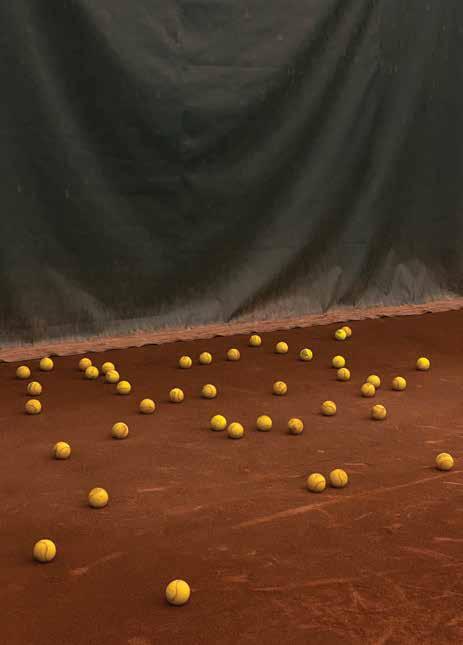
miami , everywhere / wellness 124
Back to the Baseline
When I have free time—which is rarely, and often only at my own insistent determination—I want to play tennis. I don’t want to travel (I do that for work), I don’t want to sleep (I’m anxious, so sleeping in or napping stresses me out), and I don’t want to socialize (I’m an introvert). A window in the day means I’m thinking about tennis.
Before the onset of the COVID-19 pandemic, I played the sport at a number of locations between Miami and Miami Beach. Flamingo Park in South Beach, Crandon Park on Key Biscayne, The Biltmore tennis courts in Coral Gables, Grove Isle in Coconut Grove (which, sadly, was demolished). Each has or
text by nick remsen images by vicente muñoz
an unexpected injury throws the value of tennis into stark relief for this writer and avid player
had its own unique character. Flamingo Park is kind of intense and insular: full of regulars, not particularly welcoming. Crandon Park is sprawling and buggy but fun because of all its open space. A friend and I have compared the site to what we imagine a tennis venue would look like in outer space: clinical, spheric lighting beaming down onto a vast purple surface surrounded by thick, misty night. Grove Isle was wonderful and casual; when the timing was right, you’d catch the sunset above the fences, backlighting the tips of sailboat masts.
My goal before the pandemic was to force significantly more free time and, as such, play significantly more tennis. I grew up playing it before switching to squash in my adolescent years, which was a mistake, as squash is a racquet discipline that is functionally anathema to tennis. I was left with latent muscle memory and bad habits from altering between the two. The resultant dream: to get good enough to win a local club championship. I was and am also an ardent tennis fan; my siblings and I used to autograph hunt at the U.S. Open in Queens, New York. Now, I watch it on streaming services when the tournament is unfolding (congratulations Emma Raducanu!).
The pandemic put a pause to all of that; even outdoor venues shut down for a time. To stay in shape, I started running a lot more. But consistent tennis play was further and more notably hampered when, in January 2021, I was skiing at Snowmass, part of the Aspen

127
complex in Colorado. When coming to a stop at a chairlift, my skis slid out from under me, perpendicular to the direction I was moving. They, and I, hit a jut, and “pop,” my right knee was done. The pain was initially blinding but soon vanished; perhaps it was shock, perhaps it was adrenaline. It turns out I had a tibial avulsion fracture, meaning a fragment of my tibia bone had chipped off and was floating in my kneecap—ACL attached to it—like a tethered astronaut suspended in space.
Surgery back on the East Coast was followed by a brutal month with a locked-in leg extension and ultra-reduced mobility. My sleep deteriorated. Work productivity fell off. It wasn’t so much about the physical discomfort as it was the mental roadblocks. I could think only of the maddening limitations of the problem, and the possibility that my biomechanics had changed forever. It also made me realize just how vital the activity was to my mental health—without tennis, my brain fog was distressing.
Then, after some time, the flexion in my knee began to return. I gritted through physical therapy and started stationary
biking. Distance running was not—and is still not—possible, and I wonder if it will ever be. But the ability to play tennis is back. After a summer spent largely in New York, and getting back to a modicum of normalcy playing tennis there, I finally returned to Miami, where I now play four times a week.
Each and every step of the way, my leg has felt a little better, a little freer. More so, however, the miasma of my mental health has started to clear. I’m not all the way “there” yet, but, a good sweat session under the Miami sun is far better than any medication or counseling I’ve had thus far. For a brilliant hour or two, I can sweat, swear, hit the ball as hard as I want or as tactfully as I want, and think exclusively about how to improve. Tennis didn’t save my disposition, but it eventually brought my good mood back, and a good mood goes a long way. It has to mean you’re on the right track, doesn’t it? Now let’s just hope that, in time, I win that club championship.
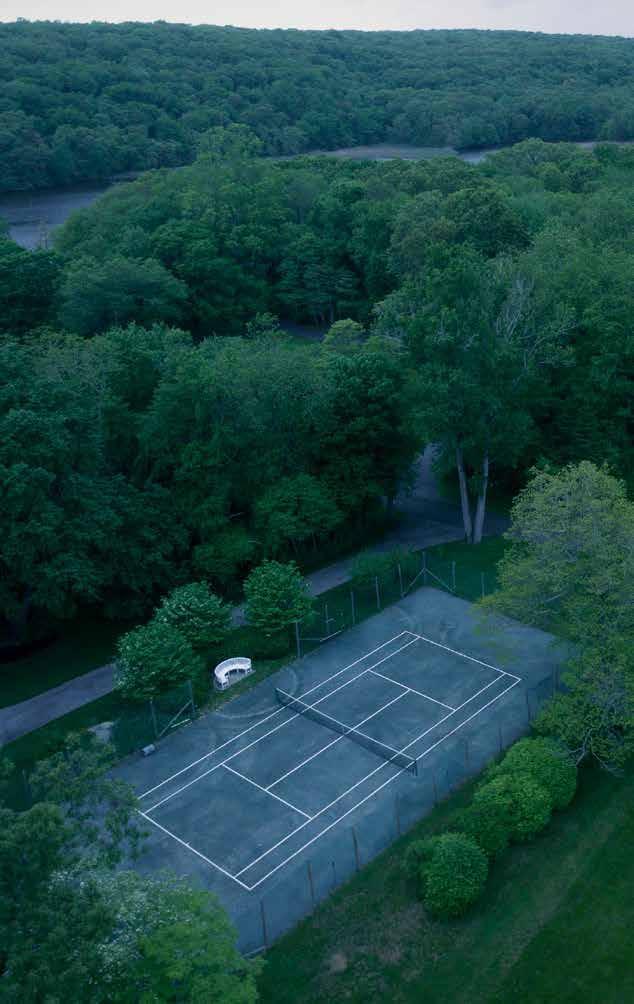
EXPERIENCE INDEX
Noteworthy Drives
text by alex schechter
artwork by osamu kobayashi
angeles crest highway from hollywood hills , california
Fifteen minutes from Los Angeles, California State Route 2 morphs into the Angeles Crest Highway, a panoramic tour de force through the San Gabriel Mountains. At Dawson Saddle (elevation 7,901 feet), take in Antelope Valley, with its hills that turn a luscious green after winter rains.
new canaan , connecticut from rye , new york
Pass under a series of Art Deco bridges on the Merritt Parkway, built in the 1930s to relieve congestion on Route 1 and now listed in the National Register of Historic Places. After 20 miles, arrive at New Canaan, Connecticut, where mid-century masterpieces are within view or open for tours, like Philip Johnson’s Glass House and the Noyes House.
overseas highway from miami , florida
This 113-mile highway completed in 1938 is the epitome of scenic byways—it is surrounded by sparkling, blue water. Set out before sunrise to have the road practically to yourself, and then stop for waffles and sticky buns at Green Turtle Inn or cruise the entire way to Key West.
old king ’ s highway from boston , massachusetts
The Old King’s Highway, a 36-mile coastal byway spanning the length of Cape Cod, was once a Wampanoag trade route; later, Mayflower pilgrims drove carts and wagons here. In Yarmouth, tour the Captain’s Mile, featuring 18th century sea captains’ homes. (Black and gold schooner plaques mark the oldest.)
tantalus drive & round top drive from honolulu , hawai ‘ i
After switchbacking through lush rainforest on the narrow Tantalus Drive, emerge at Pu’u Ualaka‘a State Park, whose grassy picnic area and trails offer views of Diamond Head and the Honolulu skyline. For more sweeping views on your return, follow Round Top Drive, first cleared in 1892 to access new land settlements (though it wasn’t paved until 1937).
lycian way from bodrum , turkey
The meandering, two-lane D400 road loosely follows the original trade route of the ancient Lycians, who founded the city of Telmessos in the 5th century BCE. From Bodrum, it’s an enchanting three-hour drive to Fethiye (modern-day Telmessos), known for its crystal-clear coves and rock tombs suspended over the edge of the Mediterranean.
130

Welcome Home
Explore Marriott International’s collection of branded residences

133
Les Nouveaux
The Ritz-Carlton Residences, New York, NoMad offer a rare opportunity to own a penthouse residence 40 stories above one of the most exciting and vibrant destinations in New York City.
The property offers Owners a stunning array of amenities and services, including a dedicated wellness floor that features the signature Ritz-Carlton Spa, helicopter views from one of the highest rooftop lounge spaces in downtown Manhattan, and access to exclusive dining opportunities, provided by internationally recognized, Michelin-starred Chef José Andrés, who is opening two highly anticipated restaurants within the building. At 500 feet in the sky, this limited collection of just 16 one- and two-bedroom penthouse residences features unparalleled, panoramic views of New York City and beyond.
The St. Regis Residences, Rye, located in the historic, celebrated, and bustling town of Rye, just 45 minutes north of Manhattan, offers hotel-style living every day of the week while maintaining the distinction of operating as the world’s first St. Regis Residences property not connected to a hotel. Residents of The St. Regis Residences, Rye will experience
exceptional, curated services provided by a Marriott International-trained St. Regis staff, including the signature St. Regis butler service and a 24-hour concierge.
Residents enjoy a seven-acre campus of lushly manicured gardens, a large central courtyard, walking paths, a grand drive court entrance with porte cochère, and underground, heated parking. The elegant residences reflect the heritage of the culture of Rye, with high-end finishes and gracious layouts.
The Residences at The St. Regis Bermuda Resort, a jewel on the Atlantic Ocean, features a luxurious contemporary design with breathtaking views through floor to ceiling windows, (or private rooftop pools and terraces,) over the sparkling beaches.
Located near the historic town of St. George’s within Bermuda’s most desirable waterfront location, residents can take full advantage of Bermuda’s renowned pinksand beaches, lush golf courses, and water adventures, as well as enviable amenities including a pool, wellness center, state-ofthe-art fitness center, two restaurants, casino, and 24/7 concierge.
learn all about marriott ’ s newest branded residences in nomad , new york city ; paradise valley , arizona ; rye , new york ; and st george ’ s , bermuda
new branded residences
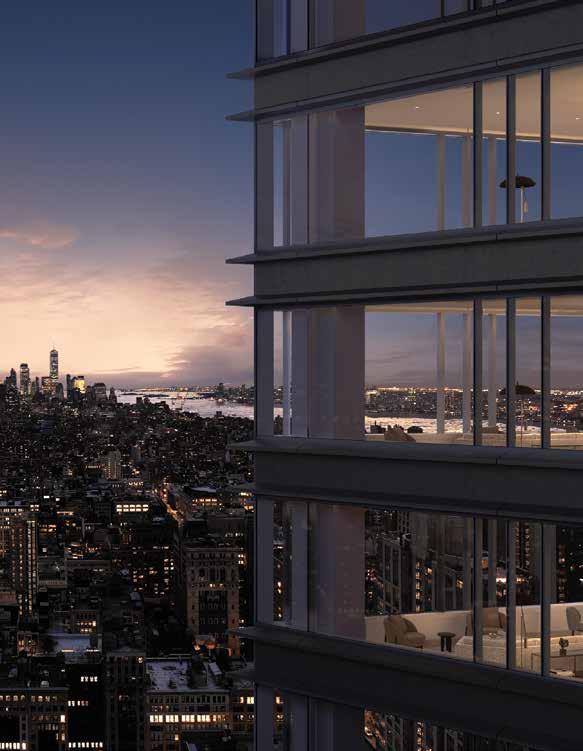
135
the ritz - carlton residences , new york , nomad rise 500 feet in the sky
LIST OF RESIDENCES
United States & Canada
alabama
The Residences at The Westin Huntsville
arizona
The Ritz-Carlton Residences, Dove Mountain
The Ritz-Carlton Residences, Paradise Valley (coming in 2022)
british columbia
The Residences at The Westin Resort & Spa, Whistler
california
The Residences at The West Hollywood EDITION
The Ritz-Carlton Residences, San Francisco
The Ritz-Carlton Residences, LA Live
The Ritz-Carlton Residences, Lake Tahoe
The Residences at The St. Regis San Francisco
W Residences Hollywood
The Residences at The Westin Monache, Mammoth Lakes
colorado
The Ritz-Carlton Residences, Bachelor Gulch
The Ritz-Carlton Residences, Vail
The Sky Residences at W Aspen
The Residences at The Westin Riverfront, Avon
district of columbia
The Ritz-Carlton Residences, Georgetown
The Ritz-Carlton Residences, Washington, D.C.
florida
Waterline Villas & Marina Residences,
Autograph Collection Residences
The Residences at The Miami Beach EDITION
The Residences at The Tampa EDITION (coming in 2022)
The Ritz-Carlton Residences, Fort Lauderdale
The Ritz-Carlton Residences, Key Biscayne
The Ritz-Carlton Residences, Coconut Grove
The Ritz-Carlton Residences, Bal Harbour
The Ritz-Carlton Residences, Singer Island
The Ritz-Carlton Residences, Miami Beach
The Ritz-Carlton Residences, Sunny Isles Beach
The Ritz-Carlton Residences, Sarasota
The Ritz-Carlton Residences, Orlando, Grande Lakes
The Residences at The St. Regis Bal Harbour
W Residences Fort Lauderdale
W Residences South Beach
georgia
The Ritz-Carlton Residences, Atlanta
The Residences at The St. Regis Atlanta
W Residences Atlanta - Downtown
hawai ‘ i
The Ritz-Carlton Residences, Kapalua
The Ritz-Carlton Residences, Waikīkī
illinois
The Ritz-Carlton Residences, Chicago
The Residences at The St. Regis Chicago
maryland
The Ritz-Carlton Residences, Chevy Chase (coming in 2022)
The Ritz-Carlton Residences, Baltimore
136
massachusetts
The Ritz-Carlton Residences, Boston Commons
The St. Regis Residences, Boston (coming in 2022)
W Residences Boston
michigan
The Residences at The Westin Book Cadillac, Detroit
minnesota
The Residences at The Westin Edina Galleria
new york
The Ritz-Carlton Residences, Central Park
The Ritz-Carlton Residences, Westchester
The Ritz-Carlton Residences, North Hills
The Ritz-Carlton Residences, New York, NoMad (coming in 2022)
The St. Regis Residences, Rye
The Residences at The St. Regis New York
W Residences Hoboken
W Residences New York – Downtown
ontario
The Ritz-Carlton Residences, Toronto
The Residences at The St. Regis
Toronto
The Residences at The Westin Trillium House, Blue Mountain
pennsylvania
The Ritz-Carlton Residences, Philadelphia
quebec
The Ritz-Carlton Residences, Montreal
The Residences at Le Westin Resort & Spa, Tremblant
texas
The Ritz-Carlton Residences, Dallas
W Residences Austin
W Residences Dallas – Victory
The Residences at The Westin Houston Memorial City
utah
The Residences at The St. Regis Deer Valley
virginia
The Residences at The Westin Virginia Beach Town Center
coming soon
New locations coming in 2023 and beyond
british columbia Kelowna
florida Clearwater Beach
Tampa
Longboat Key
georgia Buckhead
hawai ‘ i
Honolulu
ohio
Cleveland
oregon
Portland
utah
St. George
virginia
Reston
story
herein shares
Learn more at marriottresidences.com
a
in
a location with one or more of these residences .
LIST OF RESIDENCES
International
belize
Alaia Residences, Autograph Collection Residences
Marriott Residences Ambergris Caye (coming in 2022)
Banyan Bay Residences, Autograph Collection Residences (coming in 2022)
bermuda
The Residences at The St. Regis Bermuda
british virgin islands
Scrub Island, Autograph Collection Residences
cayman islands
The Ritz-Carlton Residences, Grand Cayman
china
The Residences at The Westin Tianjin
Bulgari Residences Beijing
W Residences Guangzhou
Bulgari Residences Shanghai
costa rica
W Residences Costa Rica - Reserva Conchal (coming in 2022)
cyprus
The Ritz-Carlton Residences, Limassol (coming in 2022)
greece
The Residences at The Westin Resort, Costa Navarino
indonesia
W Residences Bali – Seminyak
Bulgari Residences Bali
israel
The Ritz-Carlton Residences, Herzliya
The Residences at The Jaffa, a Luxury Collection Hotel, Tel Aviv
jordan
The Ritz-Carlton Residences, Amman (coming in 2021)
The Residences at The St. Regis Amman
kazakhstan
The Ritz-Carlton Residences, Almaty, Esentai Tower
The Ritz-Carlton Residences, Astana
The Residences at The St. Regis Astana (coming in 2021)
malaysia
The Ritz-Carlton Residences, Kuala Lumpur
The Residences at The St. Regis Kuala Lumpur
mexico
The Residences at The St. Regis Los Cabos (coming in 2022) Zadun, a Ritz-Carlton Reserve Residence
The Ritz-Carlton Residences, Mexico City
The Residences at The St. Regis Kanai Resort (coming in 2022)
The Residences at The Westin Puebla CLEVIA Residences, Autograph Collection Residences, San Miguel de Allende (coming in 2022)
The Residences at Hacienda Carretas, a Luxury Collection Hotel, Santiago de Queretaro (coming in 2022)
The Residences at Solaz, a Luxury Collection Resort, Los Cabos
The Residences at Sheraton Vitoria
montenegro
The Ritz-Carlton Residences, Montenegro
nigeria
The Residences at The Westin Abuja (coming in 2022)
oman
The Residences at The St. Regis Al Mouj Resort, Muscat (coming in 2022)
panama
JW Marriott Residences Panama
Pearl Island, a Ritz-Carlton Reserve Residence (coming in 2022)
portugal
JW Marriott Residences Algarve
The Residences at Pine Cliffs Ocean Suites, a Luxury Collection Resort
The Residences at Sheraton Cascais Resort
W Residences Algarve
puerto rico
Dorado Beach, a Ritz-Carlton Reserve Residence (West Beach and East Beach)
The Residences at The St. Regis Bahia Beach Resort
qatar
The Residences at The St. Regis Marsa Arabia Island, The Pearl Qatar (coming in 2022)
138
marriott branded residences are not owned , developed or sold by marriott international , inc or its affiliates (“ marriott ”)
saint kitts and nevis
Marriott Residences St. Kitts
serbia
The Residences at The St. Regis Belgrade (coming in 2022)
W Residences Belgrade (coming in 2022)
singapore
The Ritz-Carlton Residences, Singapore
The Residences, at The St. Regis Singapore
The Residences at W Singapore Sentosa Cove
south korea
JW Marriott Residences Jeju (coming in 2022)
Marriott Residences Daegu
spain
W Residences Marbella
thailand
The Ritz-Carlton Residences, Bangkok
The Residences at The St. Regis Bangkok
The Residences at Sheraton Phuket (coming in 2022)
turkey
The Residences at Caresse, a Luxury Collection Resort & Spa, Bodrum
The Ritz-Carlton Residences, Bodrum
The Ritz-Carlton Residences, Istanbul (coming in 2022)
The Residences at Sheraton Istanbul Esenyurt
Le Meridien Residences, Bodrum
turks & caicos
The Ritz-Carlton Residences, Turks and Caicos, Grace Bay
The Residences at The St. Regis Turks and Caicos (Grace Bay)
united arab emirates
The Ritz-Carlton Residences, Dubai, Creekside
The St. Regis Residences, Dubai
W Residences Dubai - The Palm
united kingdom
W Residences London - Leicester Square
The Residences at The Westin London City (coming in 2021)
Bulgari Residences Knightsbridge
a story in herein shares a location with one or more of these residences
coming soon
New locations coming in 2023 and beyond
argentina
Buenos Aires
aruba
belize
Ambergris Caye
brazil
Sao Paulo
Gramado
china
Lijiang
costa rica
Peninsula Papagayo
dominica
Roseau
dominican republic
Cap Cana
egypt
Cairo
indonesia
Jakarta
jamaica
Bull Bay
malaysia
Penang
Cebu
mexico
Riviera Maya
Riviera Nayarit
Los Cabos
San Miguel de Allende
morocco
Marrakech
Rabat
Tangiers
philippines
Mactan
Manila
russia
Moscow
sri lanka
Colombo
thailand
Phuket
Krabi
united kingdom
London
vietnam
Hanoi
Saigon
Learn more at marriottresidences.com
Well and Good
Wellness is important to our Owners, and our residences have uniquely special services and amenities that can be found only in a Marriott residence.
At El Mangroove Residences, Autograph Collection Residences on the Gulf of Papagayo in Costa Rica, Owners enjoy a spa and wellness experience unlike any other. Architecturally, the entire property is designed to allow the incredible natural surroundings to take hold of the senses and the Bearth Spa experience is no different—with open-air treatment cabanas, al fresco soaking pools and showers, and treatments that use only the purest natural elements. El Mangroove residents leave feeling rejuvenated—walking away as the embodiment of the country’s guiding philosophy of “Pura Vida,” pure life.
With how fast paced life is, it’s important to take time to reset and relax. At The Ritz-Carlton Residences, Chevy Chase,
residents can do just that by paying a visit to the “Mind Garden,” an outdoor, open-air meditation space where you can discover pure tranquility.
After a long day of playing golf at the worldrenowned Quivira Golf Club or enjoying the Beach Club at The Residences at The St. Regis Los Cabos, residents can make their way over to the relaxing and rejuvenating St. Regis Spa. The spa, offering ten massage rooms and a steam room, features all the elements one may need for ultimate indulgence, including gorgeous views.
Dorado Beach, a Ritz-Carlton Reserve Residence offers a one-of-a-kind spa experience for its residents at Spa Botanico. Not so long ago, on the very same island, healers known as “Manos Santas” or “Healing Hands” were prevalent in community life, and residents are treated to a nature-filled experience with wild plants and treatments taken from the history of the island.
marriott residences offer a range of services and amenities from on - demand medical care to spas overflowing with plants and views that ensure owners find wellness wherever they are
wellness
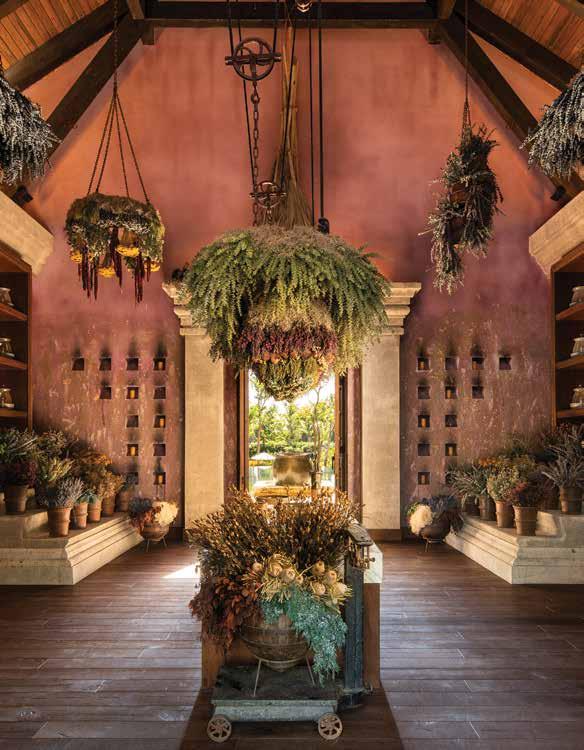
141
the spa botanico at dorado beach , a ritz - carlton reserve residence , embraces the healing power of plants
A Stay-At-Home Princess Birthday
One morning during a conversation at the Owners’ Relations Desk, an Owner informed the Residences bellman that his 7-year-old daughter’s birthday was coming soon, and that the young girl was extremely disappointed that she could not celebrate this year. Her birthday was during the lockdown mandate, as the local government’s protective measure against the pandemic.
The property was not occupied with many Owners, Owner guests, or resort guests, and all around there was a climate of isolation. The little girl was unhappy that she could not go to summer school, invite friends over to the property, or even enjoy a restaurant outing with her family.
The Residences Liaison for the property, together with the Front Desk, quickly brainstormed various surprise birthday celebration ideas that would adhere to the health and safety measures that were in place by the local government and Marriott International. The Residences Liason collected all the preferences from the young girl’s parents and decided to create a “Princess” theme, as the little girl loved the color pink, unicorns, and gymnastics.
He created a princess scavenger hunt so the birthday girl would have to follow clues to various locations on the property.
In addition, the hunt would allow her to practice her gymnastics along the way. The young princess began her scavenger hunt with her family by putting on a special princess tiara. She then visited various points around the property, and at each location, a Residences Lady or Gentleman was waiting for the family’s arrival, so she could ‘discover’ one of her favorite items. For example, at the porte-cochère meeting point, there was a princess pony piñata. The young lady completed all the scavenger hunt points, ending at the family pool where a table with unicorn balloons and a beautiful cake were waiting. A small number of Ladies and Gentlemen gathered some distance away to sing Happy Birthday, to help make her celebration fun and one of a kind. Her parents were excitedly taking video and capturing the happy moments throughout the celebration.
The Owner was incredibly pleased with all the unique touches made just for their daughter and informed the team: “I really appreciate how thoughtful and wonderful the entire Residences team has always been. Thank you so much for the wonderful birthday celebration allowing us as a family to venture outside of our home and be active on the property. It was a memory that will last us a lifetime."
at the ritz - carlton residences in waikīkī , the notion of a child having a lonely birthday motivated staff to create a magical experience
service spotlight

143
an owner ' s daughter got the royal treatment from staff at the ritz - carlton residences in waikīkī

































 text by timothy a . schuler
artwork by naomi clark
text by timothy a . schuler
artwork by naomi clark













 st peter ' s anglican church and nike bada , owner of merch design store , in st georges
st peter ' s anglican church and nike bada , owner of merch design store , in st georges


 eastender christina gibbons waits for the bus in st george ' s
eastender christina gibbons waits for the bus in st george ' s




 st peter ' s anglican church and nike bada , owner of merch design store , in st georges
st peter ' s anglican church and nike bada , owner of merch design store , in st georges


































 d ' santiago recommends visiting castelo de silves in silves , which has a lengthy and layered history .
d ' santiago recommends visiting castelo de silves in silves , which has a lengthy and layered history .























